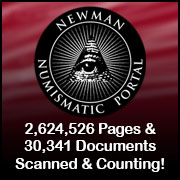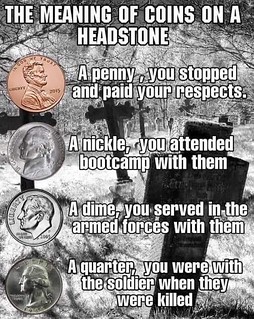
About UsThe Numismatic Bibliomania Society is a non-profit association devoted to the study and enjoyment of numismatic literature. For more information please see our web site at coinbooks.org SubscriptionsThose wishing to become new E-Sylum subscribers (or wishing to Unsubscribe) can go to the following web page link MembershipThere is a membership application available on the web site Membership Application To join, print the application and return it with your check to the address printed on the application. Print/Digital membership is $40 to addresses in the U.S., and $60 elsewhere. A digital-only membership is available for $25. For those without web access, write to: Charles Heck, Treasurer AsylumFor Asylum mailing address changes and other membership questions, contact Chuck at this email address: treasurer@coinbooks.org SubmissionsTo submit items for publication in The E-Sylum, write to the Editor at this address: whomren@gmail.com BUY THE BOOK BEFORE THE COINSale Calendar |
Volume 23, Number 22, May 31, 2020
- WAYNE'S WORDS: THE E-SYLUM MAY 31, 2020
- NBS BIBLIOTALK PODCAST INTERVIEWS DAVID HILL
- NEW BOOK: PHILIPPINE SPECIAL EDITION REDBOOK
- NEW BOOK: DANCING ON RAINBOWS
- BOOK REVIEW: ALL THAT GLISTERS IS NOT GOLD
- SALE REVIEW: BIRMINGHAM ASSAY OFFICE LIBRARY
- IRISH POLITICAL COUNTERSTAMPS ON NEWMAN PORTAL
- VIDEO: U.S. MINT DIRECTOR EVA ADAMS INTERVIEWED
- AUDIO: WHITE GOLD: EARLY ELECTRUM COINAGE
- ANS MONEY TALKS: WHAT'S NEW AT NEWMAN PORTAL?
- CONDER CAFÉ DISCUSSION GROUP
- THE ROYAL TOUCH AND SOCIAL DISTANCING
- CORONAVIRUS UPDATES: MAY 31, 2020
- NOTES FROM E-SYLUM READERS: MAY 31, 2020
- MYSTERY LIBRARY OWNER: HOWARD R. NEWCOMB
- OLIVER POLLOCK AND THE U.S. DOLLAR SIGN
- VOCABULARY TERM: MECHANICAL DOUBLING
- EDWARD CHARLES EISENGART (1874-1957)
- FLOYD HAZELWOOD'S OLYMPIC PRESS
- A. P. GIANNINI AND THE 1906 EARTHQUAKE
- MASTER INTAGLIO ENGRAVER J. BOSCO RENAUD
- MORE OVERSTAMPED U.S. DOLLAR BILLS
- A TRULY ROYAL MINT EXPERIENCE
- HOW TO RECONNECT WITH YOUR COLLECTION
- NUMISMATIC NUGGETS: MAY 31, 2020
- DNW OFFERS RARE CARAUSIUS ANTONINIANUS
- THE 1794 STARRED REVERSE CENT
- COLLECTING VATICAN COINS
- ARLINGTON NATIONAL CEMETERY TIME CAPSULE COINS
- 2020 HORNBY ISLAND TRADE TOKENS
- MEDAL OF HONOR SOLD IN GERMANY
- SCOTLAND RELEASES "FABRIC OF NATURE" BANKNOTES
- LOOSE CHANGE: MAY 31, 2020
- FEATURED WEB SITE: ANCIENT ROMAN AND GREEK COINS
Click here to access the complete archive
Click here to unsubscribe (scroll down)
To comment or submit articles, reply to whomren@gmail.com
Content presented in The E-Sylum is not necessarily researched or independently fact-checked, and views expressed do not necessarily represent those of the Numismatic Bibliomania Society.
WAYNE'S WORDS: THE E-SYLUM MAY 31, 2020
 We currently have 6,108 subscribers. Welcome to new advertiser Pierre Fricke.
We currently have 6,108 subscribers. Welcome to new advertiser Pierre Fricke.
Thank you for reading The E-Sylum. If you enjoy it, please send me the email addresses of friends you think may enjoy it as well and I'll send them a subscription (but let me know if they are located in the European Union). Contact me at whomren@gmail.com anytime regarding your subscription, or questions, comments or suggestions about our content.
This week we open with a new podcast interview, two new books, a book review, a report on the Birmingham Assay Office Library sale, and updates from the Newman Numismatic Portal.
Other topics this week include Irish political counterstamps, Conder tokens, touch pieces, U.S. Mint Director Eva Adams, Howard Newcomb, William Sheldon, Floyd Hazelwood's Olympic Press, the origin of the dollar sign, overstamped dollar bills, the 1794 Starred Reverse Cent, Vatican coins, and the Medal of Honor.
To learn more about the new Special Edition Redbook, rainbow toning, the Soho Mint, electrum coinage, Apollo 11 medals, mechanical doubling, banknote engraver J. Bosco Renaud, the Infant Head halfpence, Scotland's new banknotes, Edward Scissorhands and the zero-dollar note, read on. Have a great week, everyone!
Wayne Homren
Editor, The E-Sylum
NBS BIBLIOTALK PODCAST INTERVIEWS DAVID HILL
The latest episode of the Numismatic Bibliomania Society podcast is now available for listening. Check it out! It's on the NBS web site but also available on Apple Podcasts, Google Podcasts, Spotify, and elsewhere. Vice-President/Secretary Len Augsburger provided this report. -Editor
NBS Bibliotalk Features David Hill, American Numismatic Society (ANS) Librarian
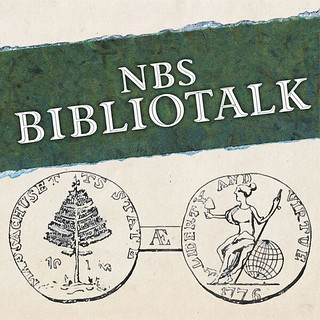 The latest episode of the NBS quarterly podcast, featuring ANS Librarian David Hill, is now posted. This wide-ranging interview, conducted by Lianna Spurrier, provides
listeners with an inside view of the ANS library, which has remained engaged during the COVID-19 shutdown. Hill covers his background as a historian and archivist and explains how
he came to succeed Elizabeth Hahn Benge as the ANS Librarian. Hill feels a kinship with previous ANS librarians and has written brief biographies of several of his predecessors in
the ANS Magazine.
The latest episode of the NBS quarterly podcast, featuring ANS Librarian David Hill, is now posted. This wide-ranging interview, conducted by Lianna Spurrier, provides
listeners with an inside view of the ANS library, which has remained engaged during the COVID-19 shutdown. Hill covers his background as a historian and archivist and explains how
he came to succeed Elizabeth Hahn Benge as the ANS Librarian. Hill feels a kinship with previous ANS librarians and has written brief biographies of several of his predecessors in
the ANS Magazine.
This interview discusses a variety of ANS archival holdings, including the Virgil Brand ledgers and Chapman brothers' correspondence. More recently, ANS acquired papers of Del Bland, Eric Newman, and George Kolbe. The Chapman correspondence in particular is currently being curated and scanned by Lara Jacobs under the sponsorship of Newman Numismatic Portal, and its organization and accessibility will be greatly improved as a result of this effort. Hill concludes with remarks about ANS library acquisitions, space, and scanning activities.
To listen to the podcast on the NBS web site, see:
https://www.coinbooks.org/
To read the earlier E-Sylum articles, see:
BIBLIOTALK: THE COIN BOOK LOVER PODCAST (https://www.coinbooks.org/v22/esylum_v22n47a02.html)
NBS BIBLIOTALK PODCAST INTERVIEWS GEORGE KOLBE (https://www.coinbooks.org/v23/esylum_v23n10a02.html)
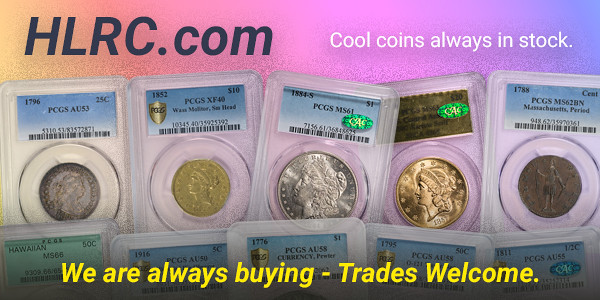
NEW BOOK: PHILIPPINE SPECIAL EDITION REDBOOK
There is a new special edition Redbook for the Philippine Collectors Forum. Thanks to Adam Spikes for alerting me to this. John Riley coordinated the project with Whitman Publishing. -Editor
Eagle-eyed Adam wrote:
"I noticed in the 2021 Red Book that there is a listing for a special edition "2021 (74th ed.) Philippine Collectors Forum / 100th Anniversary Manila Mint" edition that will have a quantity of 250 published. Unlike the "2020 (73rd ed.) Chicago Coin Club 100th Anniversary" listing from the 2020 Red Book, the new edition does not have the issue price or values identified."
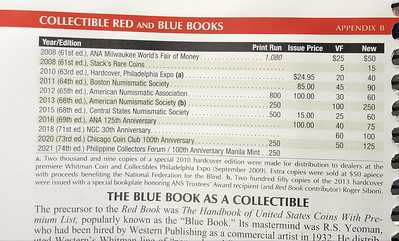
I followed up with the group, and here's the story. Thanks to John Riley and Ray Czahor for the background. -Editor
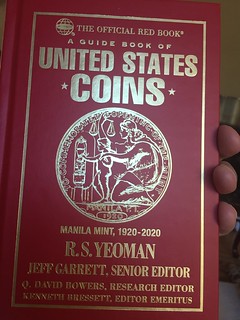
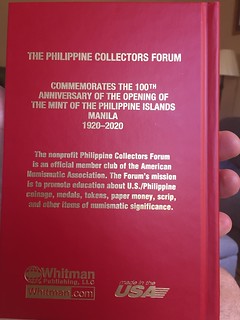
Photos by John Riley
Whitman has printed the 100th Anniversary of the Manila Mint Special Edition of its Red Book! The new hard bound Guide Book of United States Coins has a special cover with a commemorative circular design prominent in the center of the cover. It commemorates the opening of the Manila Mint in 1920, One Hundred Years ago, "Manila Mint, 1920-2020" below the design.
Within the book on the first page is a discussion of the Philippine Collectors Forum followed on the second page with the full history of the Manila Mint. This is also a standard 2021 (74th ed.) Red Book of 463 pages with a 5 page section listing Philippine coins by date in four grades.
Order this Special Edition Today! Cost of this Special Edition is $20 Postpaid within the US (outside the US such as to the Philippines, postage is extra). Proceeds above cost all go to fund the Philippine Collectors Forum and its meetings. Copies are only available from the group (please do not contact Whitman!)
To order, please contact John Riley at johnrriley@yahoo.com - he has stock at this writing (May 30, 2020).
Ray Czahor adds:
"Whitman printed 250 copies of the Special Edition. They were shipped by UPS who managed to damage/destroy two boxes of 24 copies each. One box was never delivered at all and one box shipped to me was obviously thrown/broken where the books skidded across a black dirty floor such that the covers and binding were covered with black smudges or black crud. UPS then put all the damaged books back in the same box, put tape around it and delivered it to me. This happened at my local Laurel, MD center who said they were sorry!!!!!
Given the above, 202 books were available for distribution. To date 145 books have been sold, thus leaving 57 for future sales."
John adds:
"That circular design on the front cover is actually the reverse likeness of the so-called "Wilson Dollar" HK-449 and HK-450 that was struck in 1920 to commemorate the opening of our mint in Manila, Philippines, the only U.S. Mint facility, before or since, outside of the United States. The 100th anniversary of the event is our tie-in to this project.
"Thanks to member Dennis Tucker for his great interest and help in bringing this about.
"I have about 50 copies left (most in my dining room). Only $20 postpaid. C'mon, everyone needs a Red Book anyway!"
I ordered mine!
The Philippine Collectors Forum meets annually at the ANA's World Fair of Money, currently scheduled for August 4-8, 2020 at the Pittsburgh convention center. If it happens be sure to plan to attend the Forum that meets at 1-5PM on Friday of that week. -Editor
For a video on the history of the Manila Mint, see:
The Manila Mint and the End of the Colonial era (https://youtu.be/Byiu1XVYC5Y)
NEW BOOK: DANCING ON RAINBOWS
While looking for other things I came across a short book published in December that I hadn't seen yet. Is anyone familiar with this? Copies are available on eBay, Amazon and elsewhere. Here's the product description from Barnes & Noble. -Editor
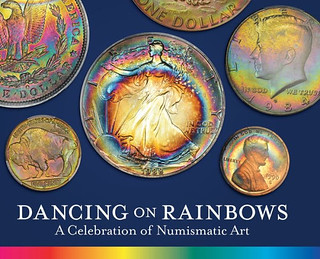 Dancing on Rainbows: A Celebration of Numismatic Art
Dancing on Rainbows: A Celebration of Numismatic Art
by Roy G. Biv
ISBN-13: 9781600251597
Publisher: Maurice Bassett
Publication date: 12/30/2019
Series: Numismatic Art , #1
Pages: 76
Product dimensions: 11.00(w) x 8.50(h) x 0.31(d)
Overview
Coin collectors have collected toned coins for years, but the popularity of rainbow-toned coins is a relatively recent phenomenon. This book is a carefully curated sampling of
some of the finest rainbow-toned coins that have come on the market in recent years.
Glowing neon colors; "Lucky Charms" colors; peacock colors; pastel colors; thick, "heavy" colors; banded rainbow colors; crescent-shaped, double crescent-shaped and arch-shaped colors and more . . . All are gathered together here for your enjoyment. While these coins are each one-of-a-kind due to their unique toning, what they do have in common, with only a few exceptions, is that they are all either rainbow-toned or "monster"-toned U.S. coins. These naturally toned coins are all works of art—nature's art.
Table of Contents
Introduction
Chapter 1: Morgan Dollars - Obverse toned
Chapter 2: Morgan Dollars - Reverse toned
Chapter 3: Eisenhower Dollars
Chapter 4: American Silver Eagles
Chapter 5: Other U.S. Coins and Medals
For more information, or to order, see:
Dancing on Rainbows: A Celebration of Numismatic Art
(https://www.barnesandnoble.com/w/dancing-on-rainbows-roy-g-biv/1135933570)

BOOK REVIEW: ALL THAT GLISTERS IS NOT GOLD
Adam Spikes submitted this review of the new novel All That Glisters Is Not Gold. Thanks! -Editor
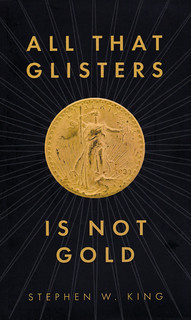 After seeing a brief review of this book included in the April 15th, 2020 edition of The E-Sylum newsletter (presumably by a non-numismatist), I was immediately
drawn to the story. Having recently read the August 2018 Coin World special edition publication "America's 'Forbidden' Coin", I knew that anyone drawing on the long
and checkered past of the 1933 Saint-Gaudens Double Eagle would certainly have a story to tell and All That Glisters Is Not Gold did not disappoint. It's kind of ironic
that a fictional portrayal of a coin that has no doubt haunted the lives of many in reality would be written by an author by the name of Stephen King. However, I do digress, this
particular account is from a former university dean on the opposite side of the country from the better-known author who in exchange for a review sent me a copy of his work.
After seeing a brief review of this book included in the April 15th, 2020 edition of The E-Sylum newsletter (presumably by a non-numismatist), I was immediately
drawn to the story. Having recently read the August 2018 Coin World special edition publication "America's 'Forbidden' Coin", I knew that anyone drawing on the long
and checkered past of the 1933 Saint-Gaudens Double Eagle would certainly have a story to tell and All That Glisters Is Not Gold did not disappoint. It's kind of ironic
that a fictional portrayal of a coin that has no doubt haunted the lives of many in reality would be written by an author by the name of Stephen King. However, I do digress, this
particular account is from a former university dean on the opposite side of the country from the better-known author who in exchange for a review sent me a copy of his work.
Set in the author's native San Francisco, a young man by the name of Lucas Bitterman sets things in motion by coming home to a wife and mother who have just received news of his Gramps' passing. Among his many possessions, Gramps leaves his extensive coin collection which included an almost complete set of Saint-Gaudens Double Eagles described as one of the best assembled to his daughter. What Lucas soon finds out is that his Gramps actually did indeed have the complete set when he is notified that he has inherited the coveted and accursed 1933. Having been tasked by his late Gramps to assist his widowed mother with the sale of his collection and to deal with the coin that "needs legal help", Lucas embarks on what becomes quite an adventure to help his mother and decide what he must do with "the" coin. Should he try to maintain ownership? There's the safe deposit box with its contents that could possibly absolve him from any legal ramifications or could it? Should he sell it? How does one sell something so valuable without it raising red flags? Or should he just get rid of it? There has to be some way to dispose of this thing without drawing unwanted attention. Researching the history of the coin, its murky legal background, and its place in history and art, Luke finds himself troubled by what others assume he may have and will stop at nothing to acquire it... even if illegally.
The book is really a fascinating read especially for any numismatist who appreciates the history of this storied coin. Having finished the book over the course of three days with my busy life, I would assume that it could be easily read over a weekend. It truly was a page-turner for me, and I expect it would be for many others. For anyone unfamiliar with the 1933 Saint-Gaudens, I recommend the Coin World publication mentioned above as a prerequisite. This publication is a great primer and would enhance the reader's experience when they read All That Glisters Is Not Gold.
Other now-dated but useful references include: Double Eagle by Alison Frankel (2006) and Illegal Tender by David Tripp (2004). And don't forget Roger Burdette's Renaissance of American Coinage 1905-1908 (2006) and Saint-Gaudens Double Eagles as Illustrated by the Phillip H. Morse and Steven Duckor Collections (2018). -Editor
To read the earlier E-Sylum article, see:
NEW BOOK: ALL THAT GLISTERS IS NOT GOLD (https://www.coinbooks.org/v23/esylum_v23n15a09.html)

SALE REVIEW: BIRMINGHAM ASSAY OFFICE LIBRARY
John Andrew submitted this great report on the recent sale of the Birmingham Assay Office Library. Thank you! -Editor
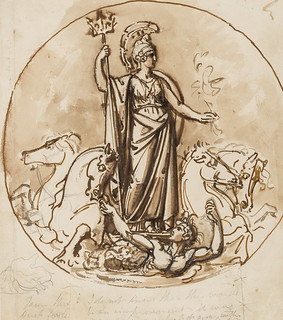

Corbould Britannia and St George Drawings
JOHN ANDREW reports
How on earth is this relevant to a numismatic publication? Matthew Boulton was born in Birmingham during 1728 and died there in 1809. By 1762 he was a major industrialist who had opened Birmingham's famous Soho Manufactory, which was purposefully designed to look like a palace. This pioneered mass production for a wide range of quality goods from buttons and buckles, steel jewellery and boxes and a few years later an extended Manufactory added luxury items such as silverware and ormolu. It was one of the first factories and certainly the most advanced one at its time in the world and lifted Birmingham to a centre of excellence, away from the 'brummagem', or inferior wares, produced there in the first half of the 18th century.
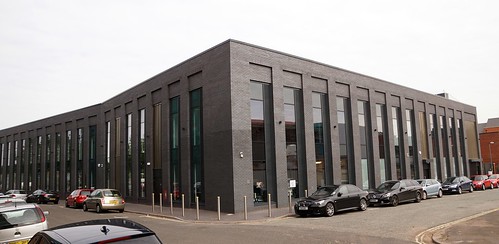
The Birmingham Assay Office
Birmingham Assay Office
The fineness of his sterling silver pieces had to be officially checked before they could be sold. This meant a 140 mile round trip by horse and cart to the nearest Assay Office
at Chester where the pieces would be hallmarked – that is stamped according to the law. Boulton considered this a serious inconvenience that was not only costly, but caused delays
and of course ran the risk of being robbed by highwaymen. By this time he had become a 'giant of industry', with the Soho Manufactory employing over 700 people. He persuaded
the Government to open an Assay Office in Birmingham.
The World's Pioneering Industrial Coiner
Having established his connection with the city's Assay Office what is Boulton's connection with numismatics? In brief, steam! In Britain at the beginning of the
18th century, only four sources of power were available – man, beast, wind and water. Enter James Watt who having trained as an instrument maker in London, returned to Scotland
and set up his business in Glasgow. He began experimenting with steam and became a leading steam engineer. In the mid-1770s Boulton and Watt entered a partnership that had a major
role in the Industrial Revolution. In 1784 a rotative engine powered by steam was developed to operate rotary machines in factories and cotton mills.
In late 18th century Britain there was a shortage of circulating small change and counterfeiting became a profitable occupation. Boulton considered that the best way to stop this was to have a vast number of official coins in circulation that had a sufficient intrinsic value and were so well executed that making false ones would not be worthwhile. An improved version of Watt's rotative engine made this possible, but in official circles his ideas initially fell on deaf ears.
The first Soho Mint was largely constructed from 1788-1789. By 1792 he had eight coin presses in operation at Soho with each capable of striking from 50 to 120 coins a minute. Boulton employed many of the best die engravers of the day, with the German Conrad Heinrich Küchler probably being the most prolific. As well as contract work for the Royal Mint and the striking of private tokens that circulated in the UK from 1787, he sent coins and tokens from Birmingham around the world – from India to Chile from Canada to Australia. In addition to installing steam-driven minting machinery at the Royal Mint, Soho also became an exporter of mints to Russia, Denmark and Brazil.
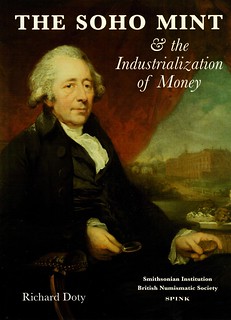 The importance of Matthew Boulton is best summarised by Richard Doty author of The Soho Mint & the Industrialization of Money (Cambridge, 1998). He describes
Matthew Boulton as 'the world's pioneering industrial coiner', adding 'every piece of money in our pockets today bears direct testimony of the work of Matthew Boulton
and the Soho Mint.'
The importance of Matthew Boulton is best summarised by Richard Doty author of The Soho Mint & the Industrialization of Money (Cambridge, 1998). He describes
Matthew Boulton as 'the world's pioneering industrial coiner', adding 'every piece of money in our pockets today bears direct testimony of the work of Matthew Boulton
and the Soho Mint.'
The Library
The Assay Office was not selling all its books, just those, according to the catalogue, that were 'not directly connected to its principal role of testing (assaying) and
hallmarking precious metals'. The diversity of the subjects offered in the 457 lots were amazing: 'alchemy, British topography, Chaucer, chemistry, design and ornament,
horology, metallurgy, mining and numismatics.' Perhaps the most perplexing one is the works of Geoffrey Chaucer 'now newly imprinted'. This was no ordinary edition, as it
was the greatest of all private press books and the apotheosis of the artistic collaboration between William Morris and Edward Burne-Jones. It sold for £40,000 including the
Buyer's Premium.
The sale of the library has not been without its critics, including letters to the national press. Locally there was less of an outcry at the general sale of the books, but protest about just one in particular. A double-page spread in The Birmingham Post (The Post) for 5th March was headed, 'Boulton's own Bible Could be lost to the city'. Matthew Boulton is quite rightly held in the highest regard in the city. The Post describes him as the 'famed 18th century Birmingham industrialist'.
At no point was it mentioned that the Bible probably left the City in 1815-16 when Matthew Boulton's son Matthew Robinson Boulton purchased the 8000 acre Great Tew Estate and manor in the Oxfordshire Cotswold Hills. Certainly he had added a Gothic Revival library in 1825. The Birmingham Assay Office bought the Bible and other volumes when Books from the library of Matthew Boulton and his family were sold by Christie's in December 1986.
To address the criticism of the Bible leaving Birmingham, the Assay Office pledged £1000 towards keeping it on public view in the city. Doug Henry, the Assay Master told The Post, 'We are keen for the title to remain in Birmingham, kept in a suitable environment and for it to be more accessible. The Assay Office pledged £1000 to help acquire the book through the auction, to ensure its safekeeping in the city and its availability for public access.
The Auction
The auction was to be staged by Forum Auctions of London at The Westbury Hotel in London's Mayfair on 26 th March, the viewing to commence on 16th - 19th March at Forum's
offices in London SW8 and from 24th-25th March at The Westbury. Coronavirus impacted upon the sale. On the evening of 16th March the UK Government asked the public to stop
non-essential contact with others as well as unnecessary travel and to work from home if possible. Upon this announcement the auction at The Westbury was cancelled and it became
an auction behind closed doors with on-line bidding only. Matthew Boulton's Famly Bible was withdrawn from the sale. On 23Srd March the Government announced stay-at-home
policy for all but essential workers. All non-essential shops and businesses were closed.
The Numismatic Books
Why the Library has so many numismatic books has never been properly explained. Undoubtedly, it is because of Matthew Boulton's connection with the Assay Office. The top price
in this part of the sale was for two volumes containing 146 original drawings and watercolours which was probably compiled from 1830-1850. Both are bound in half red morocco.
Volume one highlights include 30 sheets of portraits, some of personal interest to the artists as well other designs for coins and seals by William Wyon; a profile portrait of
William IV and the design of a coin by Sir Francis Legatt Chantrey; over 30 sheets of coin and medal designs attributed to either Edward or Henry Corbould and six sheets of
designs for crown or florin pieces by William Dyce, the designer of the Victorian Gothic florin reverse. Volume two highlights include 43 drawings (mainly of silverware) by John
Flaxman; three sheets of studies for medals, including one for the coronation of George IV by Thomas Stothard and five sheets of medals including the General Service Medal of
1793-1814. It sold for £37,500, its low estimate.
 The first single volume that caught my attention was a copy of Mr Bushell's Abridgement of the Lord Chancellor Bacon's Philosophical Theory in Mineral
Prosecutions. It appealed to me because Thomas Bushell began to establish the Aberystwyth mint in 1637 in the reign of Charles I. Apparently this was a rare work with no other
copy being traced at auction. It was published in 1659. Estimated at £600-£800 it was contested to £6000 with the Premium.
The first single volume that caught my attention was a copy of Mr Bushell's Abridgement of the Lord Chancellor Bacon's Philosophical Theory in Mineral
Prosecutions. It appealed to me because Thomas Bushell began to establish the Aberystwyth mint in 1637 in the reign of Charles I. Apparently this was a rare work with no other
copy being traced at auction. It was published in 1659. Estimated at £600-£800 it was contested to £6000 with the Premium.
Arguably the most important numismatic work in the sale, a manuscript, was the Minutes from the House of Lords' Committee of Council on Coin covering the period 1798-1802. During this time span, Soho 1797 Cartwheel two- pences and pennies were already in circulation, the Soho 1799 halfpennies and farthings were being placed into circulation and the Soho 1806 and 1807 pennies, halfpennies and farthings were not even ordered. In an age when such Minutes are printed, it is a shock seeing these handwritten. Inter alia, Matthew Boulton appeared before the Committee and was asked 1. What apparatus he would use to increase the Mint's output 2. How he would improve coins to render counterfeiting more difficult and the detection of counterfeits easier 3. Reduce operational costs. The Assay Office bought the Minutes when Books from the library of Matthew Boulton and his family were sold by Christie's in December 1986. This historically important document sold for £5000 against an estimate of £1000-£1500.
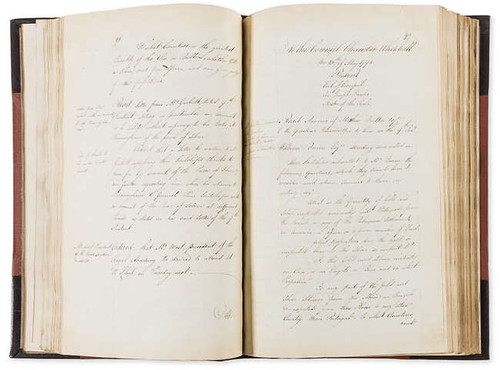
Minutes from the House of Lords' Committee of Council on Coin
 Initially I was puzzled as to why there was no copy of Ruding's Annals of the Coinage of Great Britain. When I went through the numismatic lots in greater
depth, I noticed it featured in the lot led by Cochran-Patrick's Records of the Coinage of Scotland in two volumes. The Ruding work was the second book listed and it
was the best Third Edition of 1840 bound in calf. Then my eyes lit up, as the third book was Barnard's The Casting Counter and the Counting Board of 1916. Between last
Christmas and the New Year I used an on-line text of the complete book for research into silver counter boxes. The subtitle is Chapter in the History of Numismatics and Early
Arithmetic. It is from the on-line text that I discovered that the counters in the counter boxes were not as I had thought for gaming, but for 'reckoning' – ie adding up
on a checker board. It was one of my Eureka moments of 2019!
Initially I was puzzled as to why there was no copy of Ruding's Annals of the Coinage of Great Britain. When I went through the numismatic lots in greater
depth, I noticed it featured in the lot led by Cochran-Patrick's Records of the Coinage of Scotland in two volumes. The Ruding work was the second book listed and it
was the best Third Edition of 1840 bound in calf. Then my eyes lit up, as the third book was Barnard's The Casting Counter and the Counting Board of 1916. Between last
Christmas and the New Year I used an on-line text of the complete book for research into silver counter boxes. The subtitle is Chapter in the History of Numismatics and Early
Arithmetic. It is from the on-line text that I discovered that the counters in the counter boxes were not as I had thought for gaming, but for 'reckoning' – ie adding up
on a checker board. It was one of my Eureka moments of 2019!
Then I read on and my heart sank. There were the words, 'and 10 others, numismatic', with no mention of what they were. I rang Douglas Saville who, in 2007, after 37 years at Spink's Book Department, opened Douglas Saville Numismatic Books at Caversham just north of Reading. With 50 years in numismatic books, he is the doyen of the subject. He has certainly helped me form my numismatic library over the years. I asked him if he was going for the Cochran-Patrick lot, could I bag the Barnard. The answer to both questions was yes.
Viewing the sale could well have been difficult for many potential bidders and the staff at Forum Auctions were very good providing information to potential bidders. Douglas did not view but requested images of the 10 books not listed. The lot sold for its top estimate of £750 including the Premium. This, how can I put it? 'Seems reasonable, not even knowing what the other 10 volumes were.'
I noticed that Burns Coins of Scotland (three volumes, 1887) was not listed in the sales catalogue. Neither was it listed in the published 1914 Catalogue of the Books in the Library of the Assay Office Birmingham. Interestingly the following picked at random from the 1914 catalogue were not in the sales catalogue: Anselll, A Treatise on Coining 1862 or The Royal Mint 1871; Forrer, Biographical Dictionary of Medallists, coin engravers etc (six volumes 1902-1904); Hawkins, Medallic Illustrations of the History of Great Britain and Ireland to the Death of George II (two volumes 1885) but more importantly the series of superb plates issued by the British Museum from 1904-1911. Were all these included as 'and X more, numismatic'? Or were they retained or just been lost?
Finale
Forum Auctions advise that the total hammer price was £750,000, or £937,500 with the Premium. In addition to the Kelmscott Press Chaucer, there were several other
volumes which one would not expect to find in an Assay Office's library which fetched high sums. These ranged from a volume of 26 examples of Elizabethan manuscript initials,
scripts and proverbs that sold for £33,750 to a magnificent five volume work documenting Russian life and society during the 19th century which commanded £43,750
A few days after the auction The Birmingham Civic Society announced that Boulton's Baskerville family bible had been saved and will remain in Birmingham. The announcement stated, 'A consortium consisting of the Baskerville Society (consortium leader), Centre for Printing History & Culture (Birmingham City University and the University of Birmingham), the Cadbury Research Library, Birmingham Museums Trust, Birmingham Civic Society and the Lunar Society secured the bible. It will be housed in Birmingham at the Cadbury Research Library at the University of Birmingham, which has the appropriate resources to care for it, alongside the University's many other Baskerville holdings.
In the 1970s the Assay Office passed its Matthew Boulton Archive to the Birmingham Central Library, now the Library of Birmingham. In retrospect some of the criticism of the Assay Office may not have been so harsh had it offered the House of Lords' Minutes to the Birmingham Central Library. It should have liaised with the Birmingham Civic Society regarding Boulton's Bible. Matthew Boulton is Birmingham's most famous son, indeed he is considered 'the Father' not only of the city, but the industrial West Midlands generally.
So, do I condemn the Assay Office in selling the books from its library? NO I do not! A library is only useful if it is used. I have a great interest in modern British silver, as does Ken Quickenden, who until he retired, was Research Professor at Birmingham City University. For decades, he visited the Assay Office's Library when it was located at Newhall Street in central Birmingham. He was told that he was its most frequent visitor, albeit that he only looked at it the archives as opposed to its books. During his many visits he never encountered any other researcher!
When the auction was planned, no one had a notion that the country would be placed in lockdown. This was very unfortunate, but Forum Auctions did everything to assist potential bidders. I feel justice was not done to the numismatic books and possibly the input from a consultant would have been useful. The coffers of the Assay Office have certainly been boosted.
NOTES ON IMAGES
The Birmingham Assay_Office
The Birmingham Assay Office at 1 Moreton Street on the western edge of the city's Jewellery Quarter. Courtesy Wikimedia Commons
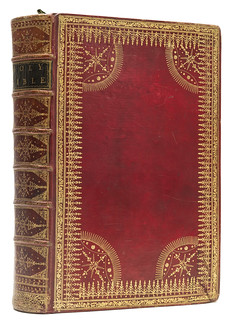 Boulton's Bible
Boulton's Bible
The is a superbly bound copy of Matthew Boulton's Holy Bible printed in 1763 by John Baskerville. Most of Baskerville's books were issued unbound, but a significant number
were bound by a particular bindery, mostly for members of Baskerville's family or friends. This particular binding is very similar to that owned by John Bskerville's wife
Sarah, although Boulton's copy is more sumptuous, using gold tooling rather than blind as on Sarah's copy. The volume passed down the generations of Matthew Boulton's
family until it was sold at auction in 1986. It was then acquired by the Assay Office. It was withdrawn from the auction and acquired by a consortium of Birmingham societies
following a public appeal. It will be housed in the city at the Cadbury Research Library at the University of Birmingham.
Bushell's Abridgement of the Lord Chancellor Bacon's Philosophical Theory in Mineral Prosecutions
There is no trace of any copy of this rare volume by Thomas Bushell, who began to establish the Aberystwyth mint during 1637 in the reign of Charles I, ever having been previously
been sold at auction. It was contested to £6000 against an estimate of £600-£800.
Corbould Britannia and St George Drawings
The auction house could not decide if these drawings could be attributed to Edward or Henry Corbould. Neither are in Leonard Forrer's Biographical Dictionary of Medalists. The
auction house favoured Edward Corbould (1815-1905) who was known for his watercolours based on literature, history and daily life. He was appointed instructor on historical
painting to the Royal Family. His father was Henry Corbould (1787-1844). His work was not generally known by the public. Although he illustrated books, most of his time was spent
making drawing of ancient marbles for the aristocracy and the British Museum, for which he was held in high regard. My view that the designs of medals and coins are by Henry
Corbould as opposed to his son. My reasoning is that he became a friend of Flaxman while at the Royal Academy and he drew the statue of Joseph Banks sculpted by Sir Francis
Leggatt Chantrey, both of whose work are in these albums. It is a shame that Henry Corbould's stunning designs never manifested into coins.
Doty's The Soho Mint
Richard Doty's excellent book on The Soho Mint is an excellent volume that details Matthew Boulton's very important contribution to modern coins. It was published
by the Smithsonian Institution in 1998 in Association with the British Numismatic Society and Spink. Its cover is the image of the portrait of Matthew Boulton by G F von Breda
executed in 1792, which hangs in the Birmingham Museum and Art Gallery. It shows the palatial Soho Manufactory in the background.
To read the earlier E-Sylum article, see:
THE BIRMINGHAM ASSAY OFFICE LIBRARY SALE (https://www.coinbooks.org/v23/esylum_v23n07a02.html)
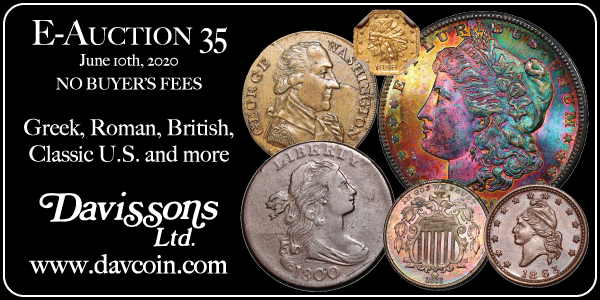
IRISH POLITICAL COUNTERSTAMPS ON NEWMAN PORTAL
The latest addition to the Newman Numismatic Portal is an Irish Political Token image collection. Project Coordinator Len Augsburger provided the following report. Thanks. -Editor
Irish Political Counterstamps on Newman Portal
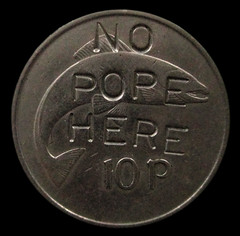 The "collector bug" launches most numismatists, but for many, commercial concerns quickly overwhelm other considerations. It is thus refreshing when an important
collection of little monetary value emerges – a reminder that we need not be slaves to price guides and ever-finer technical grades.
The "collector bug" launches most numismatists, but for many, commercial concerns quickly overwhelm other considerations. It is thus refreshing when an important
collection of little monetary value emerges – a reminder that we need not be slaves to price guides and ever-finer technical grades.
Bruce R. Mosher has been forming such a collection for a number of years, one that captures public sentiments in reaction to the Irish Troubles beginning in the late-1960s and lasting until the Good Friday Agreement of 1998. Mosher sought out counterstamped Irish and UK coins that reflect various political points of view. The first two sections, covering Loyalist and Pre-Irish Independence, are now posted on Newman Portal as image collections.
A representative example is Mosher L-89, a 1969 Irish 10p with a NO / POPE / HERE counterstamp. Mosher comments "Coin found in auction lot by seller's father, Mark Bowman, at his Antiques / Jewelery store in Greyabbey, Newtownards. It was in an old toolbox from Mackie's Engineering Works on the Springfield Rd. in Belfast, so must have been struck there. Mackie's had a predominately Loyalist work force, and was known to stamp large numbers of coins with Loyalist slogans. Apparently, this is one of them. Purchased from Niki Purce / Newtownards, Co. Down, N. Ireland." Mosher has carefully recorded provenance for every coin in the collection, a valuable record as many pieces were set aside shortly after the time of creation.
Link to Bruce Mosher Irish Political Token collection on Newman Portal:
https://nnp.wustl.edu/library/imagecollections?searchLetter=I
Link to Bruce Mosher collection inventory on Newman Portal:
https://nnp.wustl.edu/library/booksbyauthor/537948
VIDEO: U.S. MINT DIRECTOR EVA ADAMS INTERVIEWED
These are selections from the David Lisot Video Library that feature news and personalities from the world of coin collecting. David has been attending coin conventions since
1972 and began videotaping in 1985. The Newman Numismatic Portal now lists all David's videos on their website at:
https://nnp.wustl.edu/library/multimediadetail/522852
Here's one with U.S. Mint Director Eva Adams. -Editor
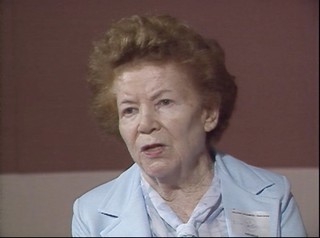 PNG Living History: Eva Adams, August 15, 1988. Sponsored by Professional Numismatists Guild. Ed Rochette, Interviewer.
PNG Living History: Eva Adams, August 15, 1988. Sponsored by Professional Numismatists Guild. Ed Rochette, Interviewer.
Ed Rochette interviews former United States Mint Director Eva Adams. They talk about collecting coins, the issue of the Kennedy half dollar in 1964, the coin shortage of the late 1960's, being on the American Numismatic Association's Board of Governors, her impressions of John Kennedy, and more. She even talks about her career before the Mint.
An excerpt of the video is available for viewing on the Coin Television YouTube Channel at:
https://youtu.be/wN131Qesd2o

AUDIO: WHITE GOLD: EARLY ELECTRUM COINAGE
The American Numismatic Society has published a new episode of their podcast, The Planchet. -Editor
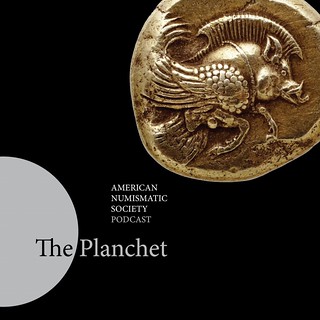 White Gold: Studies in Early Electrum Coinage
White Gold: Studies in Early Electrum Coinage
The third episode of The Planchet features guests Dr. Peter van Alfen, Chief Curator for the ANS, and Dr. Ute Wartenberg, Research Curator for the ANS (not to mention its previous Executive Director for 20 years), as they talk about early electrum coinage, archaeology, and a brief history of money.
Total Time: 57 minutes
The Planchet is available wherever you get your podcasts.
For more information, or to listen, see:
The Planchet : The Podcast from the American Numismatic Society (http://numismatics.org/planchet/)
ANS MONEY TALKS: WHAT'S NEW AT NEWMAN PORTAL?
On June 26, 2020 the American Numismatic Society will hold a virtual Money Talks presentation on the Newman Numismatic Portal. Here's the announcement from the May 2020 ANS E-News. -Editor
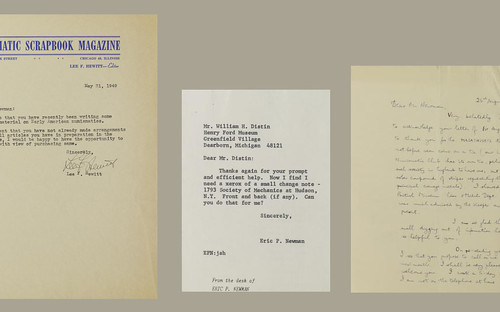
Money Talks | "What's New at Newman Portal?"
On June 27, ANS Fellow and NNP Project Coordinator Len Augsburger will present this virtual Money Talks. The Newman Numismatic Portal (NNP) is an online numismatic library that holds over 40,000 items. This presentation will provide an overview of the collection and, in particular, discuss activities at the ANS library.
The presentation is for ANS members only, but participation in events like these and the monthly ANS Magazine are just two of many great reasons to join. However, Money Talks are recorded and later uploaded to YouTube for anyone to view. -Editor
For more information on the ANS Money Talks series, see:
MONEY TALKS: NUMISMATIC CONVERSATIONS (http://numismatics.org/moneytalks/)
For information on ANS Membership, see:
http://numismatics.org/membership/
To visit the Newman Numismatic Portal, see:
https://nnp.wustl.edu/

CONDER CAFÉ DISCUSSION GROUP
Gary Groll submitted this note about the Conder Café discussion group. Thanks. -Editor

STAY CONNECTED WITH THE TOKEN COMMUNITY AT THE CONDER CAFÉ
The Conder Café is a discussion group that is dedicated to collectors, researchers, professionals, and enthusiasts of the 18th century provincial token series. It is not a marketplace, but a forum for the free exchange of information and ideas.
Topics include new discoveries, descriptive edits, updates on provenance, census, and availability, and historical context. There are always wonderful images of collector favorites, detailed points of attribution, as well as details not previously published.
It is a diverse community and there truly is something for everyone. The only real requirement is that posts stay on-topic and are related in some way to 18th century provincial tokens - which makes this the only online group solely dedicated to the series.
If you are at all interested in 18th century provincial tokens, this is clearly the place to be.
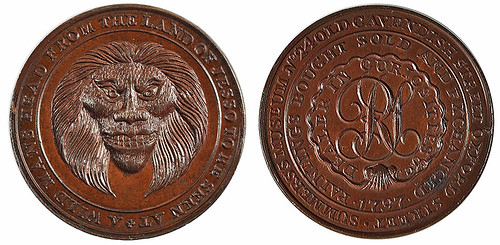
Membership is free and is currently by invitation only. So - if you are interested, here's the link to the group: https://www.facebook.com/groups/ConderCafe/
If you are not currently on Facebook, joining is quick and easy - and here's the link for that: https://www.facebook.com/help/570785306433644
If you run into any issues regarding access, or need help signing up - or have any questions, concerns, or commentary whatsoever - please contact me at gsgroll@gmail.com or to Gregg at Gregg.silvis@gmail.com
Gary adds:
"About the Conder name ... many people think James Conder was the first to catalogue the series and that is why the series was named after him. Not quite true, of course, as there were at least five others who preceded him, with the series being referred to as "Conders" relatively recently. We use it as the name of our group because Conder Cafe sounds a whole lot better than AN ARRANGEMENT OF PROVINCIAL COINS, TOKENS, AND MEDALETS ISSUED IN GREAT BRITIAN, IRELAND, AND THE COLONIES, WITHIN THE LAST TWENTY YEARS; FROM THE FARTHING TO THE PENNY SIZE CAFE.
Conder died in 1823 and his personal collection was finally auctioned by Sotheby's a generation later, in 1855. Dalton & Hamer (D&H) remains the default source for information about the series - certainly for basic points of attribution. THE PROVINCIAL TOKEN COINAGE OF THE 18TH CENTURY was published in fourteen parts between 1910 and 1918, ultimately listing over 6000 varieties. A century later, we've now documented nearly 7400 die pair and edge combinations (excluding evasions!) with new discoveries, updates, and edits ongoing."

THE ROYAL TOUCH AND SOCIAL DISTANCING
David Pickup submitted this timely article on touch pieces. -Editor
"God give you Better Health," he said, "and More Sense."
 Continuing with the theme of coins and health we turn to touch pieces. They are coins, usually made of gold, that were linked to the ancient royal ceremony when monarchs
touched people who had a disease called scrofula, a type of tuberculosis. The tradition started in the medieval ages and continued after the Reformation. The belief that a monarch
could heal people by touch was central to be the principle of Divine Right, strongly held by Charles I, as demonstrated powers given by God. Charles' father, James I had been
less enthusiastic because he thought it was too much like magic and witchcraft, a subject he had written a book on.
Continuing with the theme of coins and health we turn to touch pieces. They are coins, usually made of gold, that were linked to the ancient royal ceremony when monarchs
touched people who had a disease called scrofula, a type of tuberculosis. The tradition started in the medieval ages and continued after the Reformation. The belief that a monarch
could heal people by touch was central to be the principle of Divine Right, strongly held by Charles I, as demonstrated powers given by God. Charles' father, James I had been
less enthusiastic because he thought it was too much like magic and witchcraft, a subject he had written a book on.
Charles II touched near a hundred thousand persons. In 1682 he performed the rite eight thousand five hundred times. In 1684, the throng was such that six or seven of the sick were trampled to death. The ceremony was expensive, costing a little less than £10.000.00 a year. Royal surgeons were employed to check the crowd to distinguish those who were ill from those who came for the gold coin. Demand for the royal touch became so high that bronze or copper admission tokens were introduced to keep a record of numbers. At the ceremony, the sufferer was presented with a gold touch-piece, which would commonly be hung on a ribbon and worn as a necklace.
When James II was deposed in 1688 the new joint rulers of William and Mary refused to participate in the 'royal touch'. Opponents considered their reluctance to participate reflected doubt on their royal legitimacy. William in particular was against these ceremonies. "It is a silly superstition," he said, when he heard that, at the end of Lent, his palace was besieged by a crowd of the sick. Perhaps he did not want to get too close to the public. "Give the poor creatures some money, and send them away." On one single occasion he was requested to lay his hand on a patient and replied, "God give you better health," he said, "and more sense." His successor, Queen Anne revived the practice possibly with some private reservations but her successor, George I refused and it died out.
The practice of the royal touch was however continued by the Jacobites, who were keen to demonstrate their legitimacy. All the Jacobite Stuarts, including Charles Edward Stuart and his brother Henry Benedict Stuart, were known to have carried out the ceremony to help cure their followers. There are a number of Jacobite touch pieces, the majority of which were made in silver, although there were some gold versions produced.
To read a Wikipedia article on touch pieces, see:
Touch piece (https://en.wikipedia.org/wiki/Touch_piece)
To read the earlier E-Sylum article (with links to still earlier ones), see:
ROYAL MINT MISHAPS (https://www.coinbooks.org/v23/esylum_v23n21a21.html)
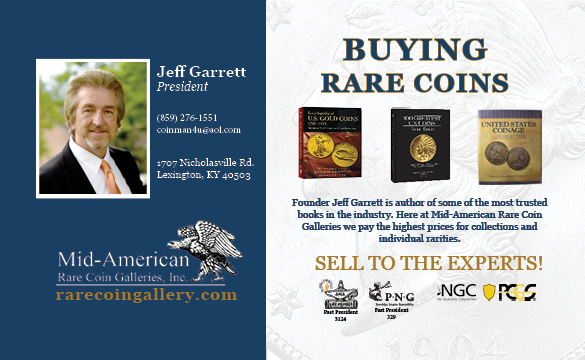
CORONAVIRUS UPDATES: MAY 31, 2020
Here's the latest compilation of coronavirus updates from readers, organizations and companies. -Editor
2020 Summer FUN Show Cancelled (May 26, 2020)

Image courtesy CDN Publishing
From the press release:
"It is with great disappointment that the FUN board of directors is announcing Summer FUN 2020 is cancelled. The FUN board has worked hard to make this show a reality, desperately wanting to provide a venue for our dealers to get back to what they love and have our numismatic community be able to convene again. However, it has become clear that the "cons" far outweigh the "pros" at this point in time.
"First and foremost is the concern for the health and well-being of our dealers, our service providers and our public attendees. There are currently many concerns and also many unknowns about how things will be in early July. The FUN board voted and approved the purchase of masks and hand sanitizer for our attendees, but was still apprehensive about being able to keep everyone safe with some level of social distancing and other safety measures.
"From Bob Hurst, President of FUN: "Our auction partner, Heritage Auctions, has endorsed this decision and has graciously agreed to transfer the Summer FUN auction consignments to their upcoming official auction of the ANA in Pittsburgh August 3rd-8th."
"From Steve Ivy, C.E.O. of Heritage Auctions: "We understand and fully endorse the decision of the FUN organization. The safety and health of the numismatic community is the first and foremost consideration. Heritage Auctions and its entire staff look forward to the upcoming winter show and auction in January with even more anticipation than normal."
"Our clubs are unable to get their members to commit to attend the show and are canceling their FUN-sponsored club buses. We believe this is a good indicator that the public is not yet comfortable attending a convention.
"If you booked a hotel reservation through FUN's official housing bureau your reservation will automatically be cancelled.
"FUN deeply regrets disappointing many people, but we look forward to better days ahead and a hugely successful show in January 2021. Thank you for your patience and understanding as we navigate these unprecedented situations."
For more information on Florida United Numismatists, see:
http://www.funtopics.com/
Tampa Coinacopia June 6th Coin Show Cancelled (May 26, 2020)
From the email announcement:
 "Due to current social distancing guidelines we are unable to host coin shows. With current news trending toward reopening of the economy soon we will be monitoring
guidelines set out by the Florida Department of Health and plan accordingly.
"Due to current social distancing guidelines we are unable to host coin shows. With current news trending toward reopening of the economy soon we will be monitoring
guidelines set out by the Florida Department of Health and plan accordingly.
"August 1st is our next scheduled show and it looks like we could potentially be open again but please keep an eye out for email updates from us as the situation is ever changing.
"STAY HEALTHY AND STAY SAFE "
Bourse Table Spacing
Alan V Weinberg writes:
 "I have been behind more than my share of major convention bourse tables (ANA, FUN, Long Beach and Baltimore shows) and I cannot recall ever being within 6 feet of
an adjoining bourse table holder. On either side or behind. So wider spacing of bourse tables does not appear to be a problem - unless the city or county dictates otherwise in
which case the ANA will have to physically demonstrate otherwise to the governing authority.
"I have been behind more than my share of major convention bourse tables (ANA, FUN, Long Beach and Baltimore shows) and I cannot recall ever being within 6 feet of
an adjoining bourse table holder. On either side or behind. So wider spacing of bourse tables does not appear to be a problem - unless the city or county dictates otherwise in
which case the ANA will have to physically demonstrate otherwise to the governing authority.
Much more problematic is the usual 2 to 3 foot spacing between a bourse seller and an interested buyer on either side of the narrow bourse table. No amount of bourse spacing can resolve that issue."
To read the earlier E-Sylum articles, see:
CORONAVIRUS COIN SHOWS (https://www.coinbooks.org/v23/esylum_v23n18a17.html)
ANA 2020 WORLD'S FAIR OF MONEY PLANNING (https://www.coinbooks.org/v23/esylum_v23n21a08.html)
Harry Laibstain Rare Coins (May 29, 2020)
From their In the Loupe email newsletter:
 "During the last several months of being home we have reinvented our business. We are now almost exclusively selling direct to collectors. The quality and selection
of our offering has grown nearly tenfold. The response has been gratifying and I want to thank everyone who has participated.
"During the last several months of being home we have reinvented our business. We are now almost exclusively selling direct to collectors. The quality and selection
of our offering has grown nearly tenfold. The response has been gratifying and I want to thank everyone who has participated.
"The future of coin conventions is still uncertain. We're not sure if the ANA show will occur. We expect the internet to dominate the coin business for the remainder of 2020. Once we feel things are safe for our staff and their family members we will resume attendance at some shows. Even then I suspect we will start to trim our schedule. Having been home for the last three months I have learned a lot, it's time to evolve and that's what we're doing. "
Black Death Era Coin Found (May 28, 2020)
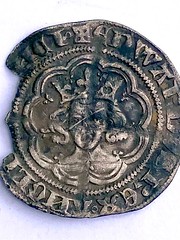 From The Metro:
From The Metro:
"NHS nurse David Lowe has made the 'weirdly relevant' find of a 670-year-old coin — minted when the 'Black Death' bubonic plague had struck.
"The amateur metal detectorist stumbled across the 14th-century half groat while searching a farmer's field in Rothbury, Northumberland.
"Mr Lowe, 55, said: 'This nice little coin popped up. To find it, 670 years later during another pandemic, is weirdly relevant. What was happening then is happening now.'"
Pandemic time capsules
From the Washington Post:
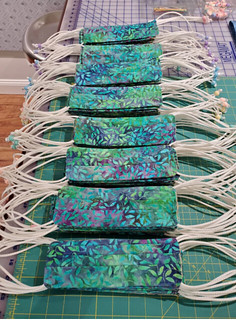 "Last week as I stopped by my local sushi restaurant to pick up a to-go order, I felt awed by the science fiction nature of the plastic wall the restaurateurs had
built to separate us. The waitress opened a transparent pass-through, like the cupboard where you put your sample in the bathroom at the lab, to set down the bagged food. After
she closed it, I picked up the bag on my side. Both of us were masked, and the stakes seemed high: It felt like "2001: A Space Odyssey" meets spider roll. As I sat in my car,
stunned by the experience, I thought, "I wish I'd taken a picture."
"Last week as I stopped by my local sushi restaurant to pick up a to-go order, I felt awed by the science fiction nature of the plastic wall the restaurateurs had
built to separate us. The waitress opened a transparent pass-through, like the cupboard where you put your sample in the bathroom at the lab, to set down the bagged food. After
she closed it, I picked up the bag on my side. Both of us were masked, and the stakes seemed high: It felt like "2001: A Space Odyssey" meets spider roll. As I sat in my car,
stunned by the experience, I thought, "I wish I'd taken a picture."
"We're living through history. Just as we pore over photographs and narratives of people in the past, those in the future will be curious about what we're doing right now, sheltered at home or on the front lines. We may have a responsibility to document our experiences, even if just for our own descendants.
"For a larger audience, who better to collect and curate such stories than the folks who have been doing it all along, the historical societies across the nation? Here's a look at a few that are working to preserve today's anecdotal evidence for tomorrow."
To read the complete article, see:
Historical societies across the U.S. are crowdsourcing pandemic time capsules
(https://www.washingtonpost.com/lifestyle/travel/historical-societies-across-the-us-are-crowdsourcing-pandemic-time-capsules/2020/05/28/41bc686e-9f54-11ea-9590-1858a893bd59_story.html)
Coronavirus Thoughts
In the we're-all-in-this-togehter-but-please-keep-your-distance department, here are some more coronavirus funnies from The Good Clean Funnies List. See more online. -Editor
New monthly budget: Gas $0, Entertainment $0, Clothes $0, Groceries $2,799.
When this quarantine is over, let's not tell some people.
I stepped on my scale this morning. It said: "Please practice social distancing. Only one person at a time on scale."
Not to brag, but I haven't been late to anything in over 6 weeks.
You know those car commercials where there's only one vehicle on the road - doesn't seem so unrealistic these days.
The dumbest thing I've ever bought was a 2020 planner.
To read the complete article, see:
We're all in this together--but please keep your distance! (https://gcfl.net/archive.php?funny=8158)
To read the earlier E-Sylum article, see:
CORONAVIRUS UPDATES: MAY 24, 2020 (https://www.coinbooks.org/v23/esylum_v23n21a09.html)

NOTES FROM E-SYLUM READERS: MAY 31, 2020
Fiber / Masticated Paper / Macerated Paper


1893 Indian Temple Pressed Paper Medal, Eglit-242.
Alan V Weinberg writes:
"On the so-called "paper" Chicago 1893 medal. The image certainly indicates a fiber content, not paper. There are quite a few fiber medals and hundreds of different fiber tokens, most notably the WWII OPA tokens."
Good point. Thanks. As noted, I was unable to locate an image of a medal made from "masticated paper" for last week's Vocabulary article. -Editor
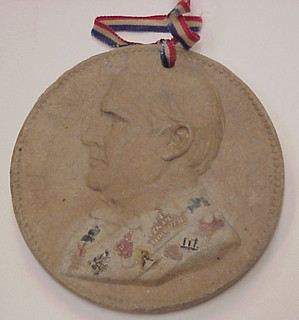
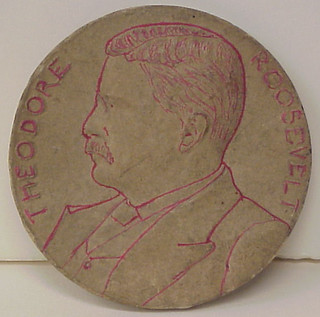
Macerated paper presidential medals: McKinley, T. Roosevelt
Rex Stark writes:
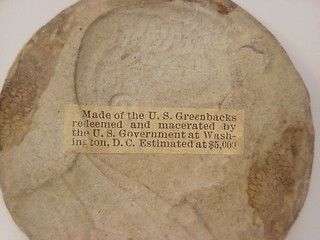 "The almost universally used term for these items is "macerated", a word used on the paper labels applied to many of the objects when they were made. Like
you, I have never seen an actual (two-sided) medal intended to be used as such, but I do have a couple of uniface copies of Presidential mint medals. On both the reverse is an
incuse image of the bust. The McKinley has promotional text from the maker in raised letters (difficult to photograph), while the TR has a paper label. Having never seen another
example, I can't say if the red highlights on TR are original to the piece. McKinley's coat has a slightly whitish tint with pieces of currency clearly visible."
"The almost universally used term for these items is "macerated", a word used on the paper labels applied to many of the objects when they were made. Like
you, I have never seen an actual (two-sided) medal intended to be used as such, but I do have a couple of uniface copies of Presidential mint medals. On both the reverse is an
incuse image of the bust. The McKinley has promotional text from the maker in raised letters (difficult to photograph), while the TR has a paper label. Having never seen another
example, I can't say if the red highlights on TR are original to the piece. McKinley's coat has a slightly whitish tint with pieces of currency clearly visible."
Alan agrees with the "macerated paper" term. I was able to locate an image of a macerated paper medal in an earlier E-Sylum. -Editor
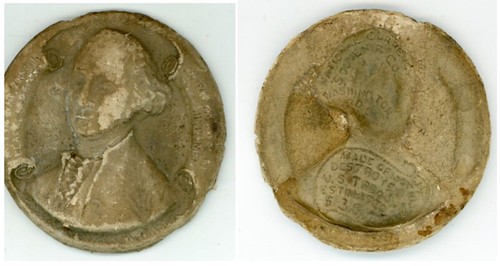
Michael Wehner writes:
"I suppose the words are synonyms. And I don't know if you would consider the attached to be a medal, but it is round..."
Michael attached images of a much better example of the same item, a medal of Washington "Made of money destroyed U.S. Treasury." Click on the images to see larger versions in our Flickr archive. -Editor
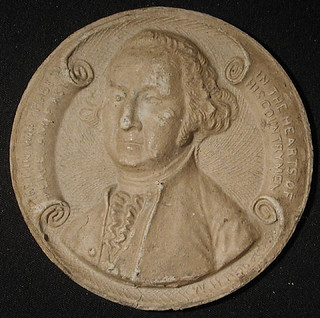
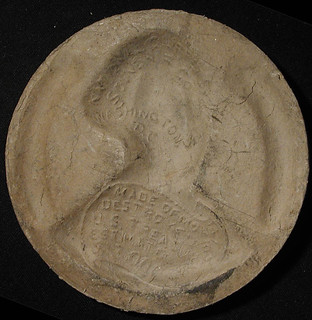
To read the earlier E-Sylum articles, see:
MACERATED CURRENCY SCULPTURES : GEORGE WASHINGTON MACERATED MONEY MEDAL
(https://www.coinbooks.org/esylum_v19n29a18.html)
VOCABULARY TERM: MASTICATED PAPER (https://www.coinbooks.org/v23/esylum_v23n21a15.html)
One thing to remember about Dick Johnson's Encyclopedia of Coin and Medal Terminology is that it is based primarily on the terms used in the field by the makers of these products. These terms may not be widely adopted by collectors. "Macerated paper" is seen more often in collecting circles. The "masticated paper" term may or may not be a mistake, although the paper label shown here is a good data point. -Editor
More on Apollo 11 Medals
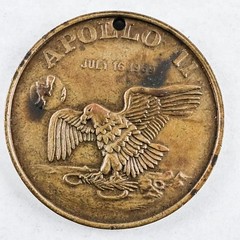
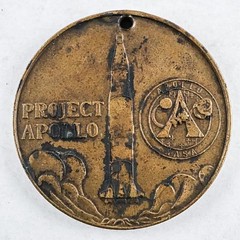
Chip Howell writes:
"16 July is the date of Apollo XI's launch, which you probably know. "Eagle" touched down on the 20th, and "Columbia" returned to Earth on the 24th. Unfortunately, I can tell you no more about this particular medal."
Correct! I saw July 1969 and didn't look much closer at that grody photo. The date is quite plain on the image below, sent by Eric Holcomb. -Editor
Eric Holcomb writes:
"The Apollo 11 / Project Apollo medal you have in the latest E-Sylum (May 24) appears to be a very common one made by Galaxy Medals Inc. in Titusville, Florida, near the Kennedy Space Center. I see the auction listing was removed, so I can't tell if it's the usual 39mm size, or might be a smaller size holed for a keyring. Attached is a composite photo of a much nicer example.
I had the exhibit of 50 different Apollo 11 medals at the ANA World's Fair of Money last summer, and do plan to contact Heritage Auctions about a possible catalog. Their current auction of space memorabilia closes on June 5. (2020 June 5 Space Exploration Signature Auction - Dallas #6227)"
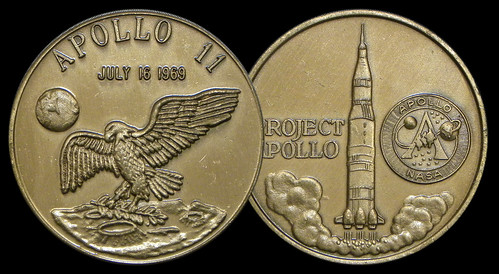
Thank you! So.... does anyone know if there any numismatic items being flown to space today, such as on Saturday's Space-X/NASA launch of two American astronauts to the International Space Station? -Editor
To read the earlier E-Sylum article, see:
NUMISMATIC NUGGETS: MAY 24, 2020 : Apollo 11 Project Medal
(https://www.coinbooks.org/v23/esylum_v23n21a25.html)
Academia.edu
Gil Parsons writes:
 "After the feature on "non-numismatic resources" in the recent issue, I bring to the attention of the readership one useful tool, which might not be as
widely known as it might be.vocab Academia.edu is a clearing house of published scholarly papers on subjects pretty much across the board. If one were to enter, say,
"nineteenth century banking" or "legal tender notes" a vast amount of relevant research would appear. I entered numismatics/medals with remarkable results.
"After the feature on "non-numismatic resources" in the recent issue, I bring to the attention of the readership one useful tool, which might not be as
widely known as it might be.vocab Academia.edu is a clearing house of published scholarly papers on subjects pretty much across the board. If one were to enter, say,
"nineteenth century banking" or "legal tender notes" a vast amount of relevant research would appear. I entered numismatics/medals with remarkable results.
The really wonderful thing is that the site then takes off on remarkable tangents and feeds much material which might at one level be peripheral but which is ultimately connected to the initial search. For a nominal fee, one can engage the "premium" service and thereby receive a great supply of articles, reviews, etc, sufficient to waste vast amounts of time (most agreeably it must be said...) Very useful to check in if one is in pursuit of esoteric numismatic knowledge..."
Great suggestion. I've been signed up for Academia.edu notifications for a while now and do discover some interesting content that way. The Premium version isn't priced nominally enough for my parsimonious tastes, although one day perhaps one of their clickbait mailings will entice me to sign up long enough to do a vanity search on my name - I'm constantly told that I'm being cited as a source but they won't divulge details without a paid subscription. I assume it's from authors referencing things found in The E-Sylum.
As an example, here's a link to a 2017 paper on colonial paper money in French North America. -Editor
To read the complete article, see:
The Wild Card: Colonial Paper Money in French North America,
1685 to 1719 (https://www.academia.edu/33718067/The_Wild_Card_
Colonial_Paper_Money_in_French_North_America_1685_to_1719)
To read the earlier E-Sylum articles, see:
USEFUL NUMISMATIC RESOURCES (https://www.coinbooks.org/v23/esylum_v23n19a25.html)
ON USING NON-NUMISMATIC RESOURCES (https://www.coinbooks.org/v23/esylum_v23n20a29.html)
A Slight Slabbing Misattribution
David Gladfelter writes:
"To paraphrase President Lincoln's famous riddle about a dog's tail, calling a note a Hoboken City Bank note doesn't make it one."
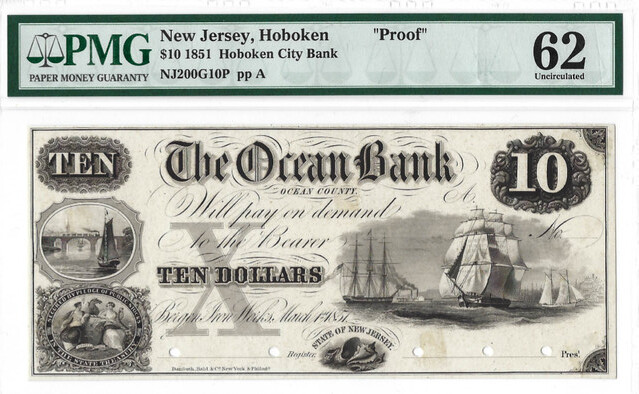
Don't believe everything you read! Thanks. They got the state right. And didn't call it a Kissi penny... -Editor
John Lupia passed along this Memorial Day graphic on the meaning of coins left on the headstone of a service member. We've covered the topic before - see below for links to earlier articles, including a discussion of related ancient traditions and the modern-day version which Snopes.com could only date back to 2009. -Editor
To read the earlier E-Sylum articles, see:
COINS LEFT ON HEADSTONES (https://www.coinbooks.org/esylum_v15n23a17.html)
COINS LEFT ON MILITARY GRAVESTONES (https://www.coinbooks.org/esylum_v17n23a21.html)
An Odd Cased Indian Cent
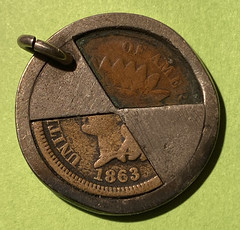
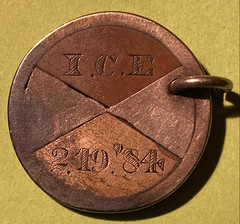
Bob Rhue writes:
"Rather fascinating workmanship to create this "mixed metal" Indian cent, commemorating some unknown event dated February 19, 1884."
Very unusual -I've never seen anything quite like this. Thanks! -Editor
Paul Seitz and Tom Elder
Dave Hirt writes:
"In the current Kolbe-Fanning sale there is a lot of Paul Seitz items. In that lot's footnotes there is a claim, which I have seen in print before, that Seitz was Tom Elder's son-in-law. I do not believe this to be true.
Many years ago at York, Pa coin show, I spoke with Paul. I asked if he was related to Elder. Seitz told me that he WAS related to Elder through his mother, and that he had handled material from the Elder estate. I asked if he had Elder auction catalogs.He said that he had some. At that time I was looking for the catalog of the Peter Mougey sale, however Paul didn't have that one."
Thanks. Nothing beats getting a report right from the source. Has anyone tried documenting the connection? -Editor
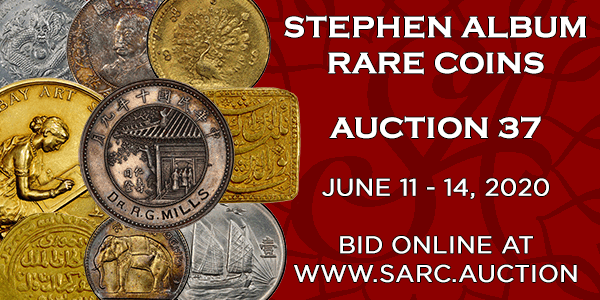
MYSTERY LIBRARY OWNER: HOWARD R. NEWCOMB
We had no takers for Pete Smith's "Mystery Library" quiz last week. It was a tough one. Given the 1930 timeframe I made a guess of "Fred Boyd", but was wrong. Here's Pete's writeup on an amazing piece of property. -Editor

Mystery Library Owner: Howard R. Newcomb
The May 24 issue of The E-Sylum included a photo of a numismatic library and asked readers if they might identify the owner.
The photo appeared in the Volume 7, No. 4 issue of Architectural Digest published in 1930. The house at 256 Copa De Oro Road, in the Bel Air neighborhood of Los Angeles, was built for Mr. and Mrs. Howard R. Newcomb in 1928 for the cost of $40.000. This was described as their "winter residence" suggesting that they still maintained a home in the Detroit area.
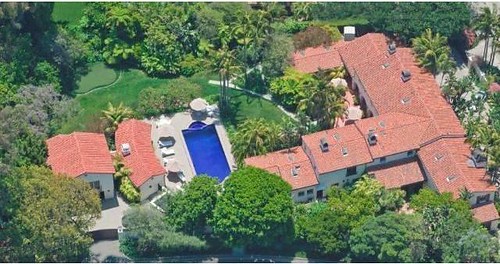
The house is described as 8,932 square feet with nine bedrooms and eight bathrooms on a .89 acre lot. It has been called "Mi Patria" since 2011. More recent owners include Robert and Nancy Daly. He was chairman and CEO at Warner Brothers. They sold the house in 2001 to Freddy DeMann, founder of Maverick Records and manager for Michael Jackson and Madonna. The house was acquired by real estate developer H. Ross Perot, Jr. for $18 million on March 27, 2013. Most recently, the house was sold to George Lucas for $33.9 million on May 25, 2017.
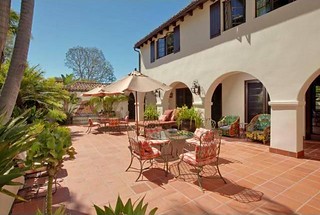 In 1906, Newcomb reported his address as 625 Woodward Avenue in Detroit. This was the home of his parents. In 1908 to 1912 his address was 24 Marston Street (or Avenue)
in Detroit. Then in 1913 he moved to 59 Burlingame Avenue (Street) where he remained until 1920 or later. This was a modest house of just 4093 square feet built in 1913. It has
seven bedrooms and four baths.
In 1906, Newcomb reported his address as 625 Woodward Avenue in Detroit. This was the home of his parents. In 1908 to 1912 his address was 24 Marston Street (or Avenue)
in Detroit. Then in 1913 he moved to 59 Burlingame Avenue (Street) where he remained until 1920 or later. This was a modest house of just 4093 square feet built in 1913. It has
seven bedrooms and four baths.
David Silverman is a house historian who is researching the Newcomb house. Silverman contacted me after reading of my discovery of a photo of Newcomb that was published in Penny-Wise in 1994.
Silverman is looking for any photos taken in the house while Newcomb lived there or stories about Newcomb while he lived there. We have exchanged comments about Newcomb's unique hand written text for his book on the U. S. Cents of 1816-1857. What happened to Newcomb's library after his death in 1945? Any material provided to me will be passed on to Silverman.
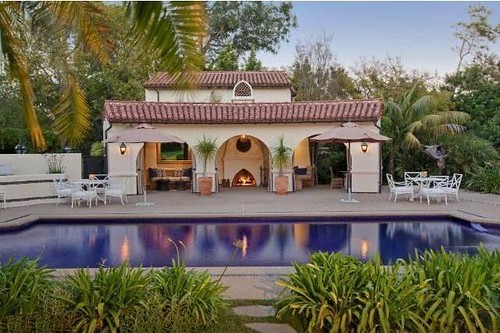
To read the earlier E-Sylum article, see:
NOTES FROM E-SYLUM READERS: MAY 24, 2020 : Quiz: Whose Library is This?
(https://www.coinbooks.org/v23/esylum_v23n21a14.html)

OLIVER POLLOCK AND THE U.S. DOLLAR SIGN
David Sundman writes:
 "You've written about the origin of the $ dollar sign several times in The E-Sylum since 2007. I recall the subject was one of Eric P. Newman's
favorites. A few months ago I found a mention on the origins of the $ sign on page 62 of this book, Brothers at Arms, American Independence and the Men of France and Spain Who
Saved It, by Larrie D. Ferreiro, that was unfamiliar to me.
"You've written about the origin of the $ dollar sign several times in The E-Sylum since 2007. I recall the subject was one of Eric P. Newman's
favorites. A few months ago I found a mention on the origins of the $ sign on page 62 of this book, Brothers at Arms, American Independence and the Men of France and Spain Who
Saved It, by Larrie D. Ferreiro, that was unfamiliar to me.
I have never seen mention of this Oliver Pollock invoice to Robert Morris origin theory mentioned in a numismatic work, have you? The reference to a specific year (1778) seems to indicate those Pollock invoices to Robert Morris exist somewhere? It would be nice to see one of the invoices.. This all seems to be consistent with your 2007 Cajori write-up."

 I did manage to find a reference to this in the E-Sylum archives. I first checked the Newman Portal for references across the body of digitized works, but came up
empty until a narrower NNP search found a November 29, 2015 E-Sylum article. Here's a short excerpt of the relevant passage. See the complete article (itself an excerpt
from elsewhere) for more. In short, Pollack was a true patriot who risked and lost his fortune bankrolling the American revolution:
I did manage to find a reference to this in the E-Sylum archives. I first checked the Newman Portal for references across the body of digitized works, but came up
empty until a narrower NNP search found a November 29, 2015 E-Sylum article. Here's a short excerpt of the relevant passage. See the complete article (itself an excerpt
from elsewhere) for more. In short, Pollack was a true patriot who risked and lost his fortune bankrolling the American revolution:
"Pollock reached into his own deep pockets and made available to the American war cause 300,000 Spanish pesos. That amount is valued at roughly one billion dollars in today's currency."
"Pollock went broke. The expensive cost of raising of armies and supplies left him with nothing."
"Oliver Pollock backed the right horse. It just didn't pay off."
At right is a sculpture of Pollack in Baton Rouge. -Editor
Washington's Superintendent of Finance, and Pollock's close friend and business partner, Robert Morris–himself a key financial backer of the Revolution–began the process by sifting through the countless ledgers sent to Congress by Pollock, who, per Dr. Cummins,"kept careful record of these amounts, noting both the Bills which he received and the supplies which he purchased."
It was with those ledgers that Oliver Pollock finally achieved his dream of providing America with an important, lasting contribution. Not the numbers, but the poor penmanship that accompanied them.
"Pollock...entered the abbreviation 'ps' by the figures for 'peso.' Because Pollock recorded these Spanish "dollars" or "pesos" as 'ps" and because he tended to run both letters together, the resulting symbol resembled a '$,'" says Jim Woodrick, the Historic Preservation Division Director of the Mississippi Department of Archives and History.
That's it. Historians have analyzed the source of the $ symbol and have yet to find it written down prior to Pollock's use in his ledgers. His unintentional creation is supported by the fact that Robert Morris chose to adopt the symbol and by 1797 had it cast in type in Philadelphia as the official symbol for new nation's own currency.
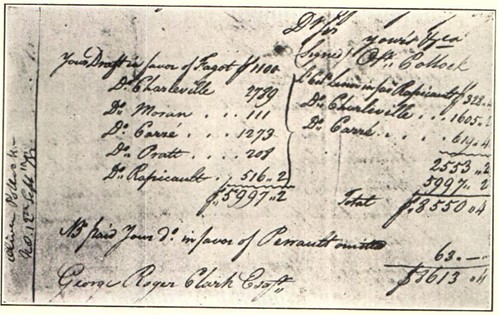
1778 letter from Pollock to George Roger Clark
That narrower NNP search also turned up references on other numismatic works, including the article by Dr. Florian Cajori in the August 1929 issue of The Numismatist where a September 12, 1778 letter from Pollock to George Roger Clark is illustrated (not the earlier-mentioned ledger entry from the same year).
Eric Newman was aware of this source when writing his 1995 ANS Coinage of the Americas Conference paper, "The Dollar $ign: Its Written and Printed Origins." Eric added material Cajori did not know about, and corrected things other people had written. Speaking of John Fitzpatrick and Oliver Pollock, his conclusion (on p20) is that they "... and many others had been sending and receiving trade documents and correspondence in great quantity using the $ sign in recognizable form, they must all be given credit for developing its practicality and its eventual general acceptance."
I wouldn't bet against Eric Newman having the last word on the topic; as he notes in this case, new inventions often have multiple mothers and fathers; more than one origin story may have credence, and we may never definitively learn of any one single first occurence of the symbol. -Editor
To read the Newman paper, see:
America's Silver Dollars: Coinage of the Americas Conference Proceedings No. 9
(https://nnp.wustl.edu/library/book/512704?page=16)
For other Oliver Pollock references on the Newman Portal, here are my search results:
https://nnp.wustl.edu/library/searchwithterms?searchterm=Oliver%20Pollock
To read earlier E-Sylum articles, see:
ARTICLE CREDITS OLIVER POLLOCK WITH CREATING DOLLAR SIGN (https://www.coinbooks.org/esylum_v18n48a15.html)
CAJORI ON THE ORIGIN OF THE DOLLAR SIGN (https://www.coinbooks.org/esylum_v19n18a18.html)
To read the Atlas Obscura article, see:
The Bankrupt Irishman Who Created the Dollar Sign by Accident
(https://www.atlasobscura.com/articles/the-bankrupt-irishman-who-created-the-dollar-sign-by-accident)
THE BOOK BAZARRE
VOCABULARY TERM: MECHANICAL DOUBLING
Dick Johnson submitted this entry from his Encyclopedia of Coin and Medal Terminology. Thanks. I've added an image from a related 2017 NGC article. -Editor
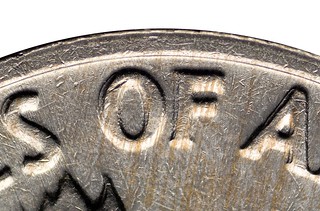 Mechanical Doubling. Tiny lines or offset around the edge of lettering because of loose dies in the coining press. Also called double line
by collectors, it shows a shift to one side forming a double outline of letters or numbers near the rim. The phenomenon is not in the die – it is not a doubled die – but is a
chattering of a loose die during striking, particularly after a long press run. It has been described as a twisting of the die as it withdraws pulling small metal relief from its
fixed position leaving large heavy relief, as a portrait or device, unaffected. It is cleared up by tightening the set bolts in the chucks holding the die in place. Such errors
are usually not collected by numismatists because of their minor interest in the field.
Mechanical Doubling. Tiny lines or offset around the edge of lettering because of loose dies in the coining press. Also called double line
by collectors, it shows a shift to one side forming a double outline of letters or numbers near the rim. The phenomenon is not in the die – it is not a doubled die – but is a
chattering of a loose die during striking, particularly after a long press run. It has been described as a twisting of the die as it withdraws pulling small metal relief from its
fixed position leaving large heavy relief, as a portrait or device, unaffected. It is cleared up by tightening the set bolts in the chucks holding the die in place. Such errors
are usually not collected by numismatists because of their minor interest in the field.
A coin with mechanical doubling can be discerned from double die coins by the clarity of the letters or figures. True double die strikes (with a die that has two identical images) have distinctly formed letters, two distinct over-lapping complete letters. Mechanical doubling is a distortion of letters which look misshapen; the top of their letters or figures are smaller than their base, with a movement of the upper part of the letters or figures to one side.
Reference:
NM19 {1991} Margolis, p 321-324.
To read the complete NGC article, see:
Doubled Dies vs. Machine Doubling
(https://www.ngccoin.com/news/article/5688/Double-Dies-vs-Machine-Doubling/)
Looking for the meaning of a numismatic word, or the description of a term? Try the Newman Numismatic Portal's Numismatic Dictionary at: https://nnp.wustl.edu/library/dictionary
Or if you would like a printed copy of the complete Encyclopedia, it is available. There are 1,854 terms, on 678 pages, in The Encyclopedia of Coin and Medal Technology. Even running two a week would require more than 19 years to publish them all. If you would like an advance draft of this vital reference work it may be obtained from the author for your check of $50 sent postpaid. Dick Johnson, 139 Thompson Drive, Torrington, CT 06790.
EDWARD CHARLES EISENGART (1874-1957)
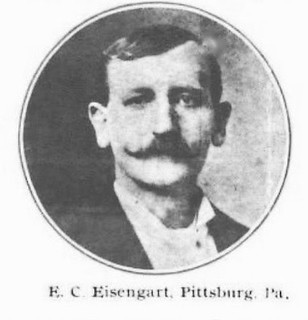 Edward Charles Eisengart (1874-1957), was born in Germany, son of Johann Eisengart (1852-1913), and Catherine Beck Eisengart (1854-1931). His family migrated to America
when he was an infant.
Edward Charles Eisengart (1874-1957), was born in Germany, son of Johann Eisengart (1852-1913), and Catherine Beck Eisengart (1854-1931). His family migrated to America
when he was an infant.
In 1888, he worked as a plate mill roller for A. M. Byers & Company. At this time he was a coin, stamp, and curio collector and dealer on the side and more than a decade later held at least two known coin auction sales.
He married Aimee Lambie (1876-1958)
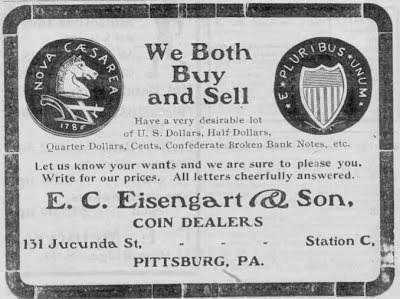
Philatelic West Vol. 22, No. 1 , January (1903) display ad.
 Eisengart was an advertiser in The Numismatist in 1900 as E. C. Eisengart & Son, himself only 26 years old.
Eisengart was an advertiser in The Numismatist in 1900 as E. C. Eisengart & Son, himself only 26 years old.
He was member No. 424, in the American Society of Curio Collectors (A. S. of C. C. ).
Eisengart held monthly coin auctions in 1904 in the first few months.
In February 1906 a public notice ran in the A. S. of C. C. Bulletin on page 17 that Eisengart has gone out of the coin business. Apparently not a life decision.
In the February 1909 issue of The Numismatist he is listed as an applicant for membership.
In 1910, he lived at 253 Charles Street, Mt. Oliver Station, Pittsburg, Pennsylvania.
In 1940, he lived in Etna, Pennsylvania.
I'm a Pittsburgh native who lived near Etna (a town right across the river) and Glenshaw, a suburb where Eisengart is buried. I was unaware of him until recently when I began compiling numismatic articles in non-numismatic publications for the Newman Numismatic Portal - I'd seen the article from the American Society of Curio Collectors (A. S. of C. C.) Bulletin. Interesting. -Editor
To read the complete article, see:
EISENGART, EDWARD CHARLES
(http://www.numismaticmall.com//numismaticmall-com/eisengart-edward-c)

FLOYD HAZELWOOD'S OLYMPIC PRESS
Pete Smith submitted this article on Floyd Hazelwood, his family and businesses in response to Dave Bowers' question on the 1969 disappearance of Jack D. Hazelwood. Thanks! Image courtesy Charles Davis. -Editor
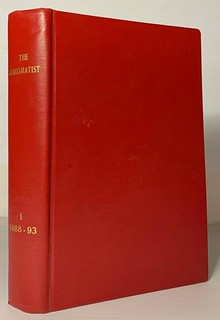 Floyd Phineas Hazelwood (1911-1983) served with the U. S. Marine Corps during the Second World War. After the war he returned home to his wife and children in Salina,
Kansas. In 1948 to joined Frank Bennett to form the Salina Coin and Stamp Shop. In 1957 he began making and selling 2x2 cardboard coin holders with acetate windows. He drove
around neighboring states providing supplies for local coin shops. The supply business covered costs and an occasional coin deal produced the profits.
Floyd Phineas Hazelwood (1911-1983) served with the U. S. Marine Corps during the Second World War. After the war he returned home to his wife and children in Salina,
Kansas. In 1948 to joined Frank Bennett to form the Salina Coin and Stamp Shop. In 1957 he began making and selling 2x2 cardboard coin holders with acetate windows. He drove
around neighboring states providing supplies for local coin shops. The supply business covered costs and an occasional coin deal produced the profits.
In 1961 Hazelwood organized the Olympic Press to produce coin supplies, philatelic supplies, and reprints of numismatic literature. An early effort was to reprint the early volumes of The Numismatic Scrapbook Magazine. These did not sell well. Later they reprinted 300 copies of the first six volumes of The Numismatist. Over the years they published three hardbound books and about fifty soft cover titles with 1000 copies of each.
Loren Hazelwood described the Olympic Press for an article in The Numismatist, July 1984, pages 1376-1380.
"Olympic's initial equipment consisted of a Heidelberg press (used almost exclusively for die cutting), Multilith 1250 offset press, paper cutter, Varitype headliner, camera and plate maker. Later a 16-station collator and a gluing machine were added."
Henry Udell Hazelwood (1912-1991) was Floyd's brother and made Plexiglas coin holders. His wife and children helped assemble the 2x2 coin holders.
Jackie (Jack) Duane Hazelwood (1937-1969) was the son of Floyd. In 1957 he joined his father to form the Wichita Coin and Stamp Company. Another business was HZD Enterprises, a large nationwide wholesale coin business, and Spartan Coin & Stamp Center.
Jack disappeared under mysterious circumstances on November 1, 1969. It could have been murder or kidnapping or a planned disappearance to avoid debt. His companies were dissolved soon after the disappearance. In 1977, a probate judge declared that he died of accidental causes on November 2, 1969. This ruling allowed settlement of the estate. In 1980, after contesting a payout, an insurance company was ordered to pay the family $375.000 in death benefits.
Loren Hazelwood was Jack's younger brother and was a charter member of the Numismatic Bibliomania Society. He formed the Numismatic Bookstall about 1978, initially to sell reminders of the Olympic Press reprints but expanding into other titles. This business closed after the death of Floyd in 1983 and unsold stock was discarded.
I talked with Loren Hazelwood on the phone in November of 2019 and we later corresponded by email. I was investigating another Akron connection unrelated to Hazelwood. He said that his brother has never turned up and his disappearance remains unsolved. He also mentioned that he took the photographs used to reprint The Numismatist. The original did not belong to his father and was borrowed but he did not recall the source.
I'm familiar with the Numismatist reprint and have a copy in my library. I recall Ken Lowe's delight in snaring a case of them for The Money Tree from Sanford Durst for $10 apiece at a time when they could be readily sold at $200 a copy.
Lot E318 in the Kolbe-Fanning Ephemera sale #4 (October 24, 2018) is a handwritten 1961 letter from Floyd Hazelwood to John Pittman. From the catalog description: "The Hazelwoods are most celebrated, however, for their facsimile reprint of the first six volumes of The Numismatist, and the letter present here establishes its beginnings and, apparently, the set from which it was duplicated. Remarkably, all of the reprints were done in Hazelwood's basement on a small printing press purchased without any prior printing experience."
I'm not at all familiar with the Numismatic Scrapbook reprints. Does anyone have any of these? Charlie reminded me that these are listed in his 1992 American Numismatic Literature book (Davis 506, p105): "The first two volumes were reprinted c1960 in slightly reduced format, the yellow covers of Volume 1 being printed with a black border while on the originals, four of the six issues have a border printed in color." -Editor
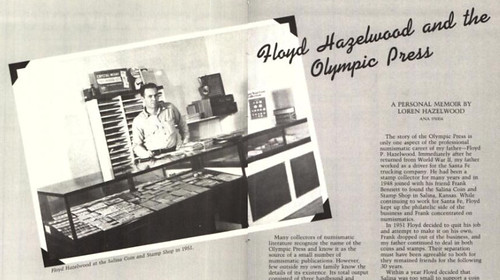
To read the Numismatist article (page 1376), see:
https://nnp.wustl.edu/library/book/527659
To read the earlier E-Sylum article, see:
NOTES FROM E-SYLUM READERS: MAY 24, 2020 : Query: Disappearance of Jack D. Hazelwood
(https://www.coinbooks.org/v23/esylum_v23n21a14.html)
A. P. GIANNINI AND THE 1906 EARTHQUAKE
I've sold off most of my bank histories over the years, but one I remember profiled Bank of America founder A. P. Giannini. A May 29, 2020 Wall Street Journal article profiles Giannini and the memorable story of his work following the 1906 San Francisco earthquake and fire. Here's an excerpt. -Editor
 A century ago, one banker was the lender of first resort when disasters hit. With coronavirus crippling the economy, we could use far more financial entrepreneurs like
him today.
A century ago, one banker was the lender of first resort when disasters hit. With coronavirus crippling the economy, we could use far more financial entrepreneurs like
him today.
His story shows that innovation often comes when unlikely people and unusual events collide. Born in 1870, Amadeo Peter Giannini quit school at age 15, becoming a wildly successful fruit-and-vegetable merchant. At the age of 31, three years before he went into banking, he had a net worth of about $300,000—more than $9 million in today's money.
"I might never have gone into the banking business," he later recalled, if he hadn't gotten into a shouting match with the head of a local bank about its reluctance to make small loans to individual borrowers. In 1904, Giannini founded a bank of his own in San Francisco, called Bank of Italy, to do just that.
Then, on April 18, 1906, an earthquake struck the Bay Area, killing more than 3,000 people and setting the city ablaze.
Realizing the fires were heading toward his bank, Giannini heaved $80,000 of gold and cash into two horse-drawn produce wagons. He buried the money under crates of oranges to hide it from looters rampaging through the streets. For weeks afterward, he recalled later, the bank's money smelled like oranges.
By the next day, the Bank of Italy had burned to the ground. But Giannini rode in from his home in San Mateo, where he had stashed the money. With San Francisco still smoldering, he set up a desk on the wharf and plunked a sack of gold on it, under a cardboard sign on a stick that read BANK OF ITALY: OPEN FOR BUSINESS.
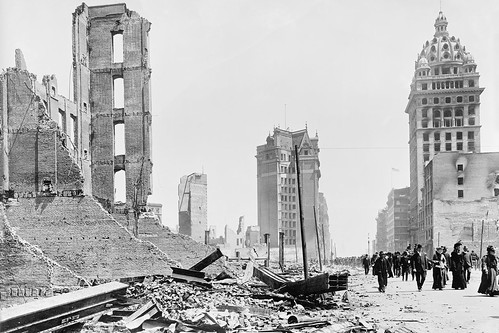
San Francisco's Market Street after the 1906 earthquake
To read the complete article (subscription required), see:
An Unlikely Hero for 1906, 1929...and Today
(https://www.wsj.com/articles/an-unlikely-hero-for-1906-1929-and-today-11590764100)

MASTER INTAGLIO ENGRAVER J. BOSCO RENAUD
This article interviews banknote engraver J. Bosco Renaud. Found via News & Notes from the Society of Paper Money Collectors (Volume V, Number 49, May 26, 2020). -Editor
 The level of microscopic detail achieved by master intaglio engraver J. Bosco Renaud places the connoisseurship of the Rio-born professional with four decades of
experience among the world's top six engravers. Bosco, as friends call him, doubles as an artist, with solo shows in major Brazilian art galleries – he now is working on his
solo exhibition "Dinheiro Virtuoso" (Virtuous Money) curated by Ricardo Ribenboim. His rare artistry also highlights projects such as the coin portrait of American film director
Tim Burton he was commissioned to create for the exhibition "The Art of Tim Burton," due in São Paulo's OCA in Ibirapuera Park after the Covid-19 pandemic ceases. The
award-winning engraver contributes to institutional publications of powerful Brazilian groups, such as Banco Itaú, Brazil's second largest bank, as well as to projects
of contemporary artists like Cildo Meireles.
The level of microscopic detail achieved by master intaglio engraver J. Bosco Renaud places the connoisseurship of the Rio-born professional with four decades of
experience among the world's top six engravers. Bosco, as friends call him, doubles as an artist, with solo shows in major Brazilian art galleries – he now is working on his
solo exhibition "Dinheiro Virtuoso" (Virtuous Money) curated by Ricardo Ribenboim. His rare artistry also highlights projects such as the coin portrait of American film director
Tim Burton he was commissioned to create for the exhibition "The Art of Tim Burton," due in São Paulo's OCA in Ibirapuera Park after the Covid-19 pandemic ceases. The
award-winning engraver contributes to institutional publications of powerful Brazilian groups, such as Banco Itaú, Brazil's second largest bank, as well as to projects
of contemporary artists like Cildo Meireles.
Always sporting a ponytail and enveloping his remarks with cryptic irony, this fast thinker is one of a handful of professionals who masterfully carry out the old art of engraving that appeared in fifteenth century Germany with Albrecht Dürer and soon evolved to money bills and security-sensitive documents to halt counterfeiting through a complex craftsmanship made of precise hair-fine lines incised in a metal plate. Intaglio engraving is a complex but subtle combination of wit to protect the security documents from fraud, and beauty to awe those handling it. Above all, this Brazilian master's unique expertise and workmanship is responsible for mint-quality intaglio and watermarks of hundreds of paper money series for several countries, including the U.S. dollar bill.
You excel in every aspect of security documents, including intaglio engraving, which you had the chance to learn from the world's greatest masters. What exactly is intaglio?
Intaglio printing is an engraving technique where the lines to be printed are cut into a copper or special steelplate with a cutting tool called a burin. Intaglio engraving is used for paper or plastic currency, banknotes, passports and high-value postage stamps.
How did you begin in intaglio engraving?
I learned the technique at the Casa da Moeda do Brasil (CMB, the Brazilian Mint) in Rio de Janeiro, where I was admitted at age sixteen when I won the first place in the civil service exams. For six month steady I was an apprentice learning everything about the tools to create smooth lines with both strength and control, later I found out that the tools become extensions of your hands and fingers much like Edward Scissorhands. It was my familiarity with the techniques that opened the doors that took me to the European masters.
Who were your European masters?
My first master was Polish-born postage stamp and banknote engraver Czeslaw Slania, I met him while I was at the Brazilian Mint. He was the most notable engraver of the twentieth century, responsible for over a thousand stamps and hundreds of banknotes for several countries, including Brazil. During World War II, Slania was in the Polish resistance where he forged documents to help his people flee the Nazi invasion, after the war he moved to Sweden and became Sweden's Royal Court and Post-Office Engraver, the highest post an engraver can achieve.
When did you work on the dollar bill?
In 1990 Italian wax engraver Luigi Casoni invited me to the watermark division at the headquarters Crane Co. & Inc. in Dalton, Massachusetts, the U.S.'s main company of currency paper, where I developed portrait drawings for the watermark of the American dollar bill with my sister Maria Renaud, a graphic designer, draughtsman and portrait artist who lives in Houston. At Crane I also developed watermarks for the Mexican passport, the 100 Mexican pesos note, and for countries like Colombia, Thailand, etc. It was an extraordinary two-year experience. While I was there I taught the process to American-born wax engraver Tom Gardner. Back in Brazil, I introduced a special wax-marked paper that was used in the national voter registration until it was digitalized in 2019.
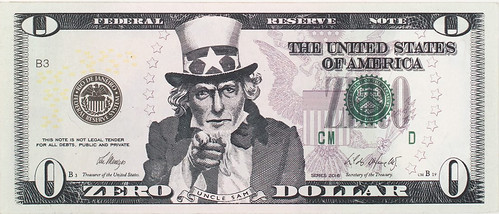
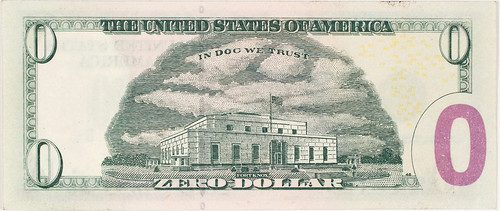
You have developed several projects with conceptual artists, among them Cildo Meireles.
I have collaborated with Cildo Meireles in several projects. I developed the engraving offset of the original Zero Dollar in 1984 which was later intaglio-printed in 2019, and the Zero Real paper money series in 2017, all of them using mint-quality intaglio and watermarks. For Cildo I also worked on the version on intaglio engraving of his "Babel" (2001) installation, which belongs to the Tate Modern.
I'd never seen the zero dollar note before. -Editor
To read the complete article, see:
Master Intaglio Engraver J. Bosco Renaud
Mixes Art and Anti-Counterfeiting Technology
(https://www.newcitybrazil.com/2020/05/26/master-intaglio-engraver-j-bosco-renaud-mixes-art-and-anti-counterfeiting-technology/)
THE BOOK BAZARRE
MORE OVERSTAMPED U.S. DOLLAR BILLS
While the U.S. Bureau of Engraving and Printing endeavors to create perfect banknotes, people can't seem to leave well enough alone - they're always decorating them with political slogans, much like the counterstamped Irish coinage seen in another article in this issue. Jud Petrie has been collecting these for some time, and shared several images with us. Thanks! See below for a link to a photo album on our Flickr archive. Here are a some samples. -Editor
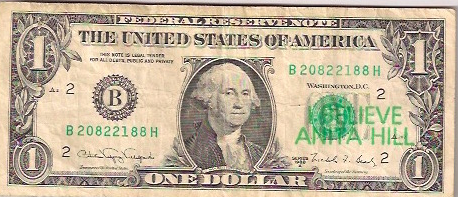
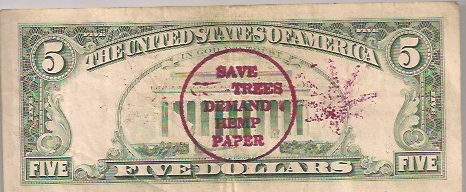

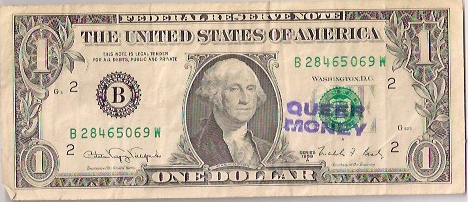


Jud writes:
"I am now a retired airline ticket agent and got all of these when I was still working, mostly obtained from the skycaps who received them as tips, and knew I collected coins and 'weird' stuff. I don't know where I got the Ron Paul bill, but it was after I retired. Although I never entered any 'Where's George' bills of my own I have entered many that I received, and would exchange them with my passengers explaining how the system worked, trying to 'put some miles' on them, selecting passengers who were going cross country or international. "
To view the photo gallery, see:
Overstamped U.S. Notes (https://www.flickr.com/photos/coinbooks/albums/72157714517816772)
To read earlier E-Sylum articles, see:
TRUMP SLOGAN ON $20 BILLS (https://www.coinbooks.org/v21/esylum_v21n20a35.html)
MORE ON POLITICAL SLOGANS ON BANKNOTES (https://www.coinbooks.org/v21/esylum_v21n21a16.html)
WAYNE'S 2019 ANA DIARY: PART II (https://www.coinbooks.org/v22/esylum_v22n34a20.html)
'REPUBLICAN SENATORS' OVERSTAMPED DOLLAR BILLS (https://www.coinbooks.org/v22/esylum_v22n35a14.html)
A TRULY ROYAL MINT EXPERIENCE
Jeffrey Kelley submitted this tale of a gracious gesture from a Royal Mint employee. Thanks! -Editor
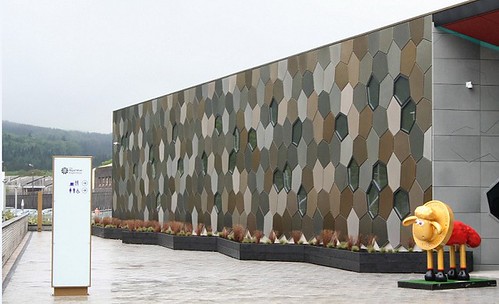
Coin Update photo
A few readers have written in recently to recount their visits to the Royal Mint in Wales, and it brought back fond memories of my own visit there in 2016, just after the The Royal Mint Experience tour first opened.
A friend and I were visiting London and we set aside a day for the excursion to Wales. We took the train from London to Pontyclun, which has the nearest train station to the Royal Mint, which is located in an industrial park in nearby Llantrisant. From Pontyclun we took a local bus to the stop nearest to the industrial park and then walked ten minutes or so to the Royal Mint. To keep things in perspective, Llantrisant is a small town, and Pontyclun is a smaller village.
Visitors are well-provided for and are hardly inconvenienced by the fact that the mint complex is a top security level facility. The tour itself is very informative, but visitors should keep in mind that their only exposure to the actual production area is viewing it through a plexiglass window.
The chance to buy a ticket to strike a coin yourself (pound coins were being struck when I visited) allows you to press a button to operate a special press located in the tour area. Had my tour been less well-attended, I might have begged the press attendant to let me create an off-center or double struck coin, although I am not optimistic that I would have been accommodated. As I recall, the pound coins we struck had a limited-edition reverse design, and some silver coins offered in the gift shop were only available there at the mint.
Our visit to the Royal Mint and the gift shop lasted until just before closing time, and after a long day we figured we would skip the bus and treat ourselves to a taxi back to Pontyclun. Someone at the visitors' center kindly called a local cab for us. After waiting a while we asked them to call the taxi company to check on our cab, and they were told that there was a large delay due to it being "rush hour". Now, this was Wales, and I was trying to envision what rush hour might look like in this bucolic region. In any case, with the mint about to close, we headed outside to wait for our taxi that might or might not show up.
As we waited outside, a mint employee who had learned of our situation approached us and insisted that we let her drive us back to Pontyclun. We were taken aback by her generosity, and it seemed almost a source of embarrassment to her that we might be left stranded there. We accepted her offer, and we enjoyed some very insightful conversation on the ride back.
This trip was just weeks after the historic Brexit vote, and she provided some very spirited commentary on the issue and the key players; her position was that membership in the EU was a financial net gain for Wales, and that Wales received a level of recognition and respect that was not afforded by the UK government. When we reached Pontyclun it was dinnertime and she recommended a couple restaurants and refused to accept any money for "petrol".
When traveling in Europe my friend I are firm believers in the idea that "getting there is half the fun." In this particular case, "getting out of there" provided one of the most memorable experiences as we found that the Welsh people are unbelievably nice.
To read the 2016 Coin Update article, see:
Grand Opening: "Royal Mint Experience" Visitor Center
Welcomes Coin Enthusiasts and Friends (http://news.coinupdate.com/preview-royal-mint-experience-visitor-center-welcomes-coin-enthusiasts-and-friends/)
To read earlier E-Sylum articles, see:
ROYAL MINT EXPERIENCE CENTER OPENS (https://www.coinbooks.org/esylum_v19n21a33.html)
ROYAL MINT COIN SCULPTURES (https://www.coinbooks.org/v23/esylum_v23n20a44.html)
MORE ON THE ROYAL MINT EXPERIENCE EXHIBITS (https://www.coinbooks.org/v23/esylum_v23n21a20.html)
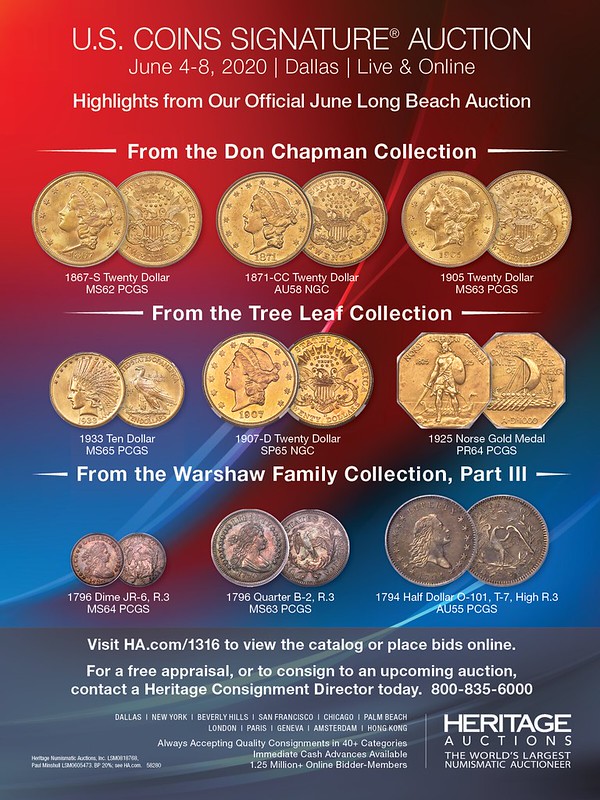
HOW TO RECONNECT WITH YOUR COLLECTION
Tom Kays is a member of my Northern Virginia numismatic social group Nummis Nova. We share numismatic fellowship over dinner at restaurants in the area. It's been a while since our last get-together, In the meantime, Tom submitted these thoughts on working with one's collection. Thanks! -Editor
How to Reconnect with Your Collection at Home
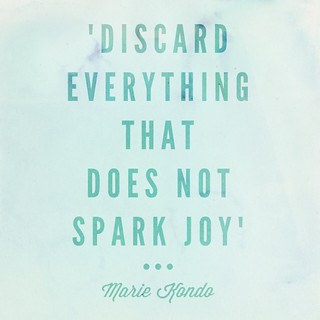 Nummis Nova missed three monthly dinners in a row, something that never happened before. Thwarted table talk topics are building up, needing an outlet. Here is a virtual
numismatic dinner talk I would have sprung on those that used to sit nearby as we would await appetizers and salad. Given plenty of at home time these days, now is a great
opportunity to reconnect with your stay-at-home hobbies, to rediscover what is in your collection.
Nummis Nova missed three monthly dinners in a row, something that never happened before. Thwarted table talk topics are building up, needing an outlet. Here is a virtual
numismatic dinner talk I would have sprung on those that used to sit nearby as we would await appetizers and salad. Given plenty of at home time these days, now is a great
opportunity to reconnect with your stay-at-home hobbies, to rediscover what is in your collection.
I've been collecting coins for over half a century and never had time to look through them as I have just done, with the Japanese organizing consultant Marie Kondo's method of downsizing in mind. Marie Kondo wrote about tidying up to transform your life. I envision a coin collection half the size it presently occupies. Would you believe just a 10% reduction? That would spark joy for me, I think. It is hard to get rid of good coins.
After a lifetime of acquiring, deaccessioning is a foreign concept altogether. Where to start? Marie Kondo was once a school librarian who truly loved to organize books on shelves. She had a crisis the day they decided to get rid of some books, willy-nilly, messing up her careful shelving patterns. It wasn't until she had a vision about the downsizing process itself, of deciding what books to keep, not about deciding what to trash, that she saw a new pattern for "right-sizing" a collection. Marie Kondo advises not to look at what to throw out, but to focus category-by-category and one-by-one on things to keep.
Prioritize any way you like. Start with all things in a single category. Gather all together and look over the small mountain of flips, 2X2s, sets, rolls, books, cabinets, fruit jars, and any other container holding coins, from spare change to slabbed proofs. Can you visualize how tall, wide, and deep a pile of gelt they make? Does it make your heart flutter, throb, and palpitate to see such a pile? Does it spark joy like Scrooge McDuck? Probably not. Then get started looking at each item in the pile, one-by-one, and decide which items have an honored place in your collection. What is the first thing you would grab for the keeper pile? Those selected must both 'spark joy' as you clutch it in your hand and have an honored place in your ideal future collection. Move those high priority items to their place of keeping. Take your time. You are assembling a more refined collection, not getting rid of anything. Tired of all the choosing and stashing? Has the remaining pile diminished very much?
Whatever is left in the pile at the end has no honored place of keeping, fails to spark joy, and dilutes your fine collection of keepers. Those leftover, unloved specimens obviously need to be boxed up and discarded. Marie advises you to hold them one-by-one and silently thank them for their service in gracing your collection, and then let them go.
Coins in the "can't stay-must go" pile likely take thought on how to best monetize them, spend them, or donate them. Consider giving wheat cents to young numismatists, home schoolers, and boy scouts needing to earn their coin collecting badges, to ensure a bright future for the hobby. Service industry folks used to appreciate excess bicentennial clad half dollars and circulated two-dollar bills. What about miscellaneous foreign coins deemed unimportant to your downsized, and much improved coin collection holding only the best, joy-sparking gems.
What am I ready to discard? How about every Susan B. Anthony Dollar acquired in change? How about every modern clad mint set, and some silver proof sets acquired from yard sales and even those I bought direct from the US Mint in the 1980s and 1990s. The point is if I ever want one back, it is easy to find them again at every numismatic sales venue. Why am I caring for them and storing them for decades as though they are precious? When seeing my whole collection at once these contribute much bulk, and very few sparks of joy. Add to them every Lincoln cent I ever stashed away from change. I found several gallons of them in the past fifty years filtering them out of circulation like a bottom-dwelling mollusk, staring in the 1970s as I tried to fill the ubiquitous Blue Whitman Folders. Now they occupy milk jugs too heavy to lift. I find small cents too mean to look through for dates and errors. Kid stuff. I could spend my hobby time doing better. Add to them that box of copper cents (and a few coffee cans) stashed away in the 1980s when copper cents began to exceed their face value. I still don't want them melted, but now commerce has stopped taking change all across the nation due to health concerns. Really, it is time to lift these boat anchors and give 'em the old heave-ho over-the-side to lighten the load on my collection. Let me add state quarters and America-the-Beautiful quarters by the roll, saved from circulation at the premier of each. Can I add Mint wrapped rolls of gold dollars, and even stacks of clad Ike dollars, again neat when they were new, but now why save 25 examples when less than one would make me happy?
I'm on the fence about excess 90% silver found roll-searching back in the 60s when every roll had some. I pulled one of each year and mint to save. The remainder seems a bit damp at sparking joy, nor do they have an honored place of keeping. Duplicates? I never knew how many duplicates of everything from half cents to half dollars I put away. With time at home I compared duplicates and dropped inferior pieces in the 'to-go' box. Wholesale release of much of my Canadian coins, and many miscellaneous foreign coins also need to drop in the outgoing chute, not having any theme, rhyme or reason, other than they got stuck in my bottom-feeding filter along with wheat cents.
Now for the big surprises. Coins that I used to collect, series that are complete (or as near complete as I intend to make them), and those I can never complete seem to have lost that spark of joy. Owning them is not as much fun as finding hole fillers in my travels. The thrill of the hunt and all that, but no such trophy of completion floats my boat as it once did. What to do with incomplete sets of circulated Barber dimes and quarters?
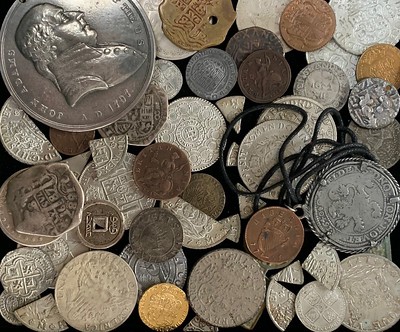
Counterfeits, copies, and modern fantasy pieces may be uninteresting individually, each a disappointment that it is not real. Put them together in a draw sting bag as a "Black Cabinet" and they find a new use as conversation starters with folks not normally interested in looking at old coins. Might these be keepers?
As I went through my collection a few series I looked forward to, finally seeing them in one spot. They topped my keeper list such as Bust Half Dollars and better, older foreign coins having an exciting history. I like them still. Every time I look them over, I imagine who used them and how they came to be in my collection. One surprise was in totaling all my counterfeits in a pile. They each by themselves would be unchosen, but taken together, rekindled some interest as conversation starters. The best discriminator of 'sparking joy' is whether I want to spend time enough to update my inventory or if I couldn't be bothered to devote any more time to preserving and organizing them. If I drop them in the discard box so much less work. That helps push those sitting on the fence into the discard chute.
Joy is sparking here, looking at what little I decided to keep. Marie Kondo's method works even for items inherited or obtained from friends long ago, that have emotional connection, but not numismatic interest. Keep a keepsake for the memories, but no need to store a shoebox of indifferent coins from the same well-remembered source. Thank them for their service in recalling your friend or ancestor to mind and send them on. Let them spark joy with new owners, perhaps with a bit of the story of what they meant to you and how you acquired them.
Side benefits of this exercise included 'reholdering' all my coins in safe flips, correction of errors in coin/holder match-ups, putting all the keepers in sequential order (that really points out duplications), variety checks, and removing all real and suspected PVC plastic flips. I treated some coins that turned green with a light acetone bath - that worked wonders, especially on silver coins.
It has been a worthwhile exercise all-in-all that I never would have had time to do except for following the Governor's stay-at-home orders. Now I have stock to sell or trade when in-person coin shows resume. I have donations for future kids and youth numismatic events. I have new collecting priorities, and I have a new appreciation for those best coins in an honored keeping place. Know the difference between 'joy sparkers' and sludge, junk, and bottom-feeder debris, from a lifetime of numismatic filtering. You can make the hobby new again if you renew and refine your collection by the Marie Kondo method. Tidying up - who knew it would feel so good?
As virtual bread, butter, and imaginary salad plates appear I would make one last push for those across the Nummis Nova table to try this joy sparking method and let me know how it goes for them next month, at the next virtual dinner. We know full well that only a select few folks have the in-check, collector-bug constitution to go through with it, not that the rest are necessarily 'Scrooge McDucks,' but I suspect they remain unmotivated at the thought of spring cleaning, or perhaps they find their 'sparks' in other pursuits while cooped up at home.
Thanks, Tom! Great advice for all of us. I've been doing something similar with my numismatic books and ephemera. I've culled out a number of boxes of non-joy-sparkers that I hope to find new homes for through a combination of donations and sales. They were all the apple of my eye at one point with much to be said for them, and have survived multiple culling exercises over the years - they just aren't a fit for me anymore, and might prove to be important hole-fillers or collection-starters for someone else. -Editor
NUMISMATIC NUGGETS: MAY 31, 2020
Here's a selection of interesting or unusual items I came across in the marketplace this week. Tell us what you think of some of these. -Editor
1760 Voce Populi Infant Head Halfpence


Nelson-1, W-13820 'Infant Head' variety, considered to be Rarity-6.
A rare, distinctive and seldom seen variety with a youthful obverse portrait.
And this is a fantastic example with rich medium brown color, hard smooth surfaces, a sharp and even strike and nothing in the way of post minting issues.
From Coin Rarities Online. -Editor
To read the complete lot description, see:
1760 Voce Populi ½p Infant Head, Rarity-6
(https://www.coinraritiesonline.com/product/1760-voce-populi-%c2%bdp-19/)
Book: Medals of the British Navy
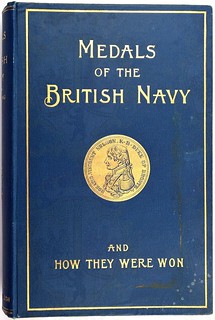 MEDALS OF THE BRITISH NAVY, and how they were won, W.H. Long, London 1895, zahlr. Farbtafeln, 450 S., goldgepr. Ln., m. Ex-Libris John Gretton (1. Baron of Stapleford,
1867-1947, 2facher Goldmedaillen-Gewinner d. Olympischen Spiele Paris 1900, Geschäftsmann u. konservativer Politiker
MEDALS OF THE BRITISH NAVY, and how they were won, W.H. Long, London 1895, zahlr. Farbtafeln, 450 S., goldgepr. Ln., m. Ex-Libris John Gretton (1. Baron of Stapleford,
1867-1947, 2facher Goldmedaillen-Gewinner d. Olympischen Spiele Paris 1900, Geschäftsmann u. konservativer Politiker
For bibliophiles and medal collectors is this book on British Navy medals. -Editor
To read the complete lot description, see:
Lot 350: MEDALS OF THE BRITISH NAVY
(https://www.invaluable.com/auction-lot/MEDALSOF-THE-BRITISH-NAVY-350-c-79C4EB2978)
1933 Lincoln Exhibit Medal

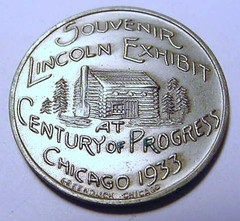
1933 LINCOLN EXHIBIT AT THE CENTURY OF PROGRESS EXPO MEDAL
Nice medal. This exhibit was sponsored in part by the Lincoln National Life Insurance Co. Below is a link to a digital copy of the exhibit brochure from the University of Illinois at Urbana-Champaign. -Editor
To read the exhibit brochure, see:
The Abraham Lincoln exhibit group, Century of Progress, 1833 to 1933,
Chicago. (https://babel.hathitrust.org/cgi/pt?id=uiuo.ark:/13960/t9t163p7x&view=1up&seq=5)
To read the complete lot description, see:
Lot 348: 1933 LINCOLN EXHIBIT AT THE CENTURY OF PROGRESS EXPO
MEDAL (https://www.invaluable.com/auction-lot/1933-LINCOLN-EXHIBIT-AT-THE-CENTURY-OF-PROGRESS-E-348-c-3CA4432B3A)
Gettysburg National Parks Medal

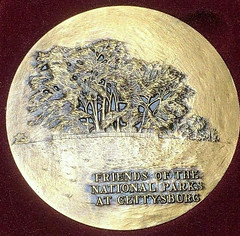
GEM FRESH QUALITY. HEAVY SUCKER.
RARE AND HARD TO FIND.
WITH ORIGINAL BOX, EVERYTHING IS CRISP FRESH
NO PAMPHLET INCLUDED, I DON'T THINK THEY OFFERED ONE
MEASURES 3 INCHES ACROSS. THICK AND HEAVY
MEDALLIC ART COMPANY. STAMPED YEAR 2000 ON THE EDGE.
The Medallic Art Company produced a vast number of great medals over the years, and I'm always running into ones I hadn't seen before. like this Gettysburg medal. -Editor
To read the complete lot description, see:
RARE MACO Civil War GETTYSBURG REMEMBRANCE TRUST BRONZE MEDAL National Parks (https://www.ebay.com/i/383530037432)
1955 Doubled Die Obverse Lincoln Cent
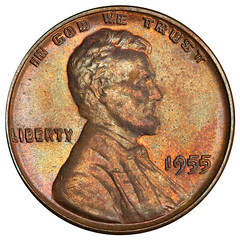
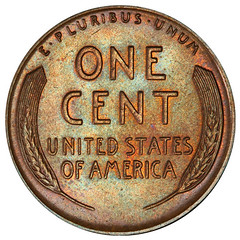
1955 1C DOUBLED DIE OBV DDO PCGS MS64BN CAC
I noticed this one in the stock of Harry Laibstain Rare Coins. Beautiful coin. -Editor
To read the complete lot description, see:
1955 1C DOUBLED DIE OBVE DDO PCGS MS64BN CAC
(http://www.hlrc.com/Inventory/CoinViewer?id=869642002&c=23)
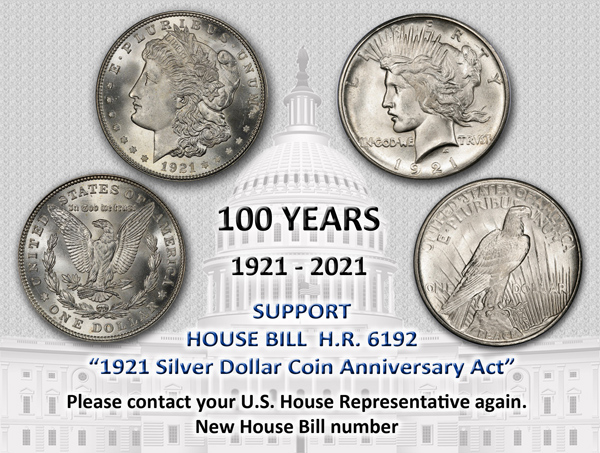
DNW OFFERS RARE CARAUSIUS ANTONINIANUS
David Pickup and David Sundman forwarded information about a rare piece being offered next month by Dix Noonan Webb. Thanks. Here's the press release. -Editor
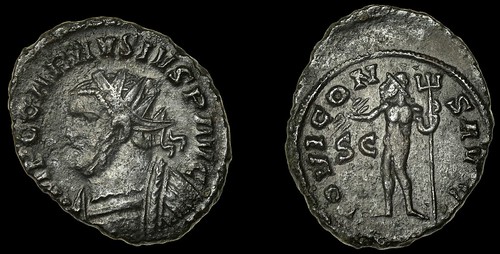
An extremely rare coin was minted by the Emperor Carausius, the first ever Brexiteer, who rebelled against the Roman Empire and led a breakaway British Empire between 286-293 is to be offered by International coins, medals, banknotes and jewellery specialists Dix Noonan Webb in a live online auction of Ancient and Islamic Coins on Wednesday, June 3, 2020 at 11am on their website www.DNW.co.uk.
The bronze coin, known as an antoninianus, was struck by Carausius in 291 in order to pay his army. It was discovered by Kevin Scillitoe in Colchester and is one of only two known examples with this reverse. Kevin found the coin in the mid 1970s when he was just a 10 year-old boy. At the time, the river in Colchester was being dredged and the resulting spoil heaps were deposited along the roads leading out of the town. These mounds attracted the attention of Colchester's schoolchildren who sifted through the dirt using kitchen sieves in the hope of finding lost Roman treasures. Kevin found several Roman coins while searching which he has kept ever since and he only realised the importance of this coin when he saw the only other known example prominently exhibited in the British Museum.
As 57-year-old Kevin, who works in construction noted: "It was 1974-75, as it was a school day, and me and my older sister were dropped off for the day on a heap of dirt, put their by lorries not sure why but possibly to make verges along the Barrack Road in Colchester, there was about 20 people mainly youngsters going through the soil. In those days it was my job to dig the vegetable patch at home, and sieve for stones. So I took the sieve with me and I found about 3 coins, but this particular coin stuck out and seemed special, as it was so well preserved."
He went on to say: "After finding the coin I saved up my pocket money until I had enough to purchase a metal detector and that is how I started my metal detecting adventure. Over the years I found and sold many coins, but I could never find a reference to this coin, and have never found a bronze Roman coin in such good condition. It wasn't until early this year that I read a report of a similar coin, that I believe was found in Lincolnshire and is in the British Museum at the moment."
As Bradley Hopper, Coin Expert at Dix Noonan Webb explains: "The obverse of the coin shows a portrait of the rebel emperor Carausius facing left, while the reverse shows the god Jupiter. This god was considered by the Romans as the divine protector of both the Roman Empire and the emperor personally."
He continues: "This depiction of Jupiter is interesting as the god is holding a trident, an item normally associated with the sea god Neptune. Images of Jupiter holding a trident are extremely rare, and this image which assimilates aspects of the two gods into a single figure appears to show that Carausius was claiming divine support from both Jupiter and Neptune. We know from other historical sources that in 290 Carausius successfully defended his British Empire from an invasion by the Roman Emperor Maximian, and the appearance of Neptune's trident on this coin suggests that Carausius successful defence of his British Empire involved victory in an otherwise unrecorded sea battle."
He finishes by saying: "We have estimated the coin to fetch £800-1,000 but we hope that it will sell for much more."
To read the complete press release, see:
RARE COIN LINKED TO THE FIRST EVER BREXITEER AND DISCOVERED IN COLCHESTER ALMOST 50 YEARS
AGO TO BE SOLD AT DIX NOONAN WEBB IN JUNE (https://www.dnw.co.uk/news-and-events/latest-news/article.php?article_id=410)
To read an article in The Times (subscription required), see:
Boy who dug up Roman coin hopes to make a pretty penny
(https://www.thetimes.co.uk/article/boy-who-dug-up-roman-coin-hopes-to-make-a-pretty-penny-ht8jqlcch)
To read the complete lot description, see:
Roman Imperial Coinage, Carausius, Antoninianus,
(https://www.dnw.co.uk/auctions/catalogue/lot.php?auction_id=554&lot_uid=363588&search=1)

THE 1794 STARRED REVERSE CENT
Doug Nyholm published an article on the 1794 Starred Reverse Cent in the May 2020 issue of The Mint Master from the Utah Numismatic Society. With permission, we're republishing it here. Thanks! -Editor
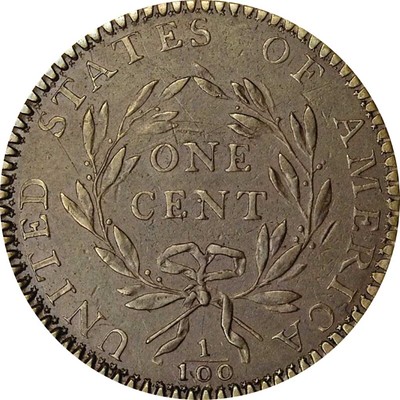 This month I'm writing about a coin that essentially needs no introduction. For most numismatists the mention of a "Starred Reverse Cent" immediately brings an exact
vision of what coin is being discussed. But, for those of you who may be novices or are unfamiliar, the exact description is of a 1794 S-48 Large Cent with 94 tiny stars punched
among the denticles on the reverse. I have in my library several books which have been written in their entirety about a single coin or variety and this rare large cent is one of
them. Others include the 1913 Liberty Head Nickel, an 1804 Dollar, the 1802 Half Dime, 1822 Gold Half Eagle, the 1793 S-15 Large cent, an 1838-O Half Dollar, and also a 1894-S
Barber Dime to name a few. The 1794 Starred Reverse cent is even more specific, and it is not only being referred to by the date but by a specific Sheldon variety, S-48, which is
one of dozens of known varieties for the date.
This month I'm writing about a coin that essentially needs no introduction. For most numismatists the mention of a "Starred Reverse Cent" immediately brings an exact
vision of what coin is being discussed. But, for those of you who may be novices or are unfamiliar, the exact description is of a 1794 S-48 Large Cent with 94 tiny stars punched
among the denticles on the reverse. I have in my library several books which have been written in their entirety about a single coin or variety and this rare large cent is one of
them. Others include the 1913 Liberty Head Nickel, an 1804 Dollar, the 1802 Half Dime, 1822 Gold Half Eagle, the 1793 S-15 Large cent, an 1838-O Half Dollar, and also a 1894-S
Barber Dime to name a few. The 1794 Starred Reverse cent is even more specific, and it is not only being referred to by the date but by a specific Sheldon variety, S-48, which is
one of dozens of known varieties for the date.
There has been much written regarding this coin but very little is known about the why's other then conjecture and guessing. Large cents have been collected and favored by collectors as far back as the time when they were being minted and later gained a large following after their discontinuance in 1857. Several monologues were written, and varieties identified but this Starred Reverse was not discovered until 1877, twenty years after the last large cent was minted. The discovery is amazingly documented as follows: In 1877 Henry C. Chapman, along with his brother S. Hudson Chapman, who were well known coin dealers and auctioneers along with Dr. Edward Maris, a Quaker physician were examining a group of large cents and one was picked up and Chap-man exclaimed, "Here is a die with minute stars around the reverse." Dr. Maris, an expert at the time on early coppers stated that 'this was previously unknown." This discovery coin was later offered on Feb 11-12 in 1880 by the Chapman brothers auction as part of the Samuel A. Biuspham Collection.

Within several years two others were discovered and as of today approximately 60 of this Sheldon S-48 are known to collectors. The 94 stars are punched among 83 denticles which are not evenly spaced between the denticles due to the different numbers, seven of them are even hidden under some of the denticles while only two are completely visible Most of the known examples are all in low grade with the finest grading PCGS AU-58, four others grade VF, a few Fines while the others are quite worn. In the past few decades several have actually been cherry-picked from hoards or groups of lower grade large cents and I suspect there still may be a few hiding out there.
 The mystery as to the why and how this variety was created has been open to speculation and discussion ever since the variety was discovered. It rivals the "E" and "L"
counterstamped 1815 and 1825 Bust quarters and similarly may never be fully understood. This is just what makes this hobby so interesting and compelling. There have been a number
of theories put forward, one that I have run across most often is someone with an idle hour at the mint just decided to play around with a star punch on one of the dies.
Interesting, but most likely not the actual reason. Another theory is that it was intended to be an anti-counterfeiting scheme, interesting, but with edge lettering in use at the
time probably not the reason. One other speculation was that the stars represented the signers of the Declaration of Independence. There are 94 stars and only 56 signers of the
Declaration, however. One final theory was that the stars were placed on pattern coinage planchets from 1792 that never got used then later pulled from storage and overstruck in
1794.
The mystery as to the why and how this variety was created has been open to speculation and discussion ever since the variety was discovered. It rivals the "E" and "L"
counterstamped 1815 and 1825 Bust quarters and similarly may never be fully understood. This is just what makes this hobby so interesting and compelling. There have been a number
of theories put forward, one that I have run across most often is someone with an idle hour at the mint just decided to play around with a star punch on one of the dies.
Interesting, but most likely not the actual reason. Another theory is that it was intended to be an anti-counterfeiting scheme, interesting, but with edge lettering in use at the
time probably not the reason. One other speculation was that the stars represented the signers of the Declaration of Independence. There are 94 stars and only 56 signers of the
Declaration, however. One final theory was that the stars were placed on pattern coinage planchets from 1792 that never got used then later pulled from storage and overstruck in
1794.
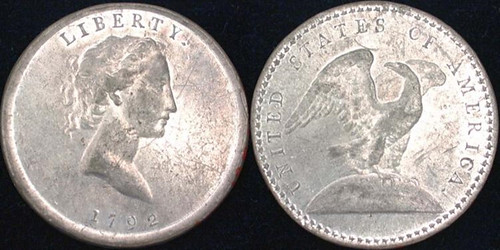
One of the more interesting, and possible plausible theories, is the one regarding the Wright pattern 1792 Eagle on Globe pattern quarter dollar. This pattern is of similar size to a large cent (both have a diameter of 29 mm) and this quarter pattern has a boarder of 87 small stars of roughly the same style. There are differences in the stars and they are not punch-linked to each other. From 1792 to 1794 there was certainly experimentation and trials and patterns which were struck at the fledgling mint. The starred reverse cent may have simply been nothing more than one of these experiments with border ornamentation. Unless some long-lost document or information is uncovered, we will probably never know for certain what was intended. In the meantime, the S-48 cent is of great numismatic interest and value with the AU specimen selling for $632,000 in Feb. of 2008 at a Heritage auction.
Author Pete Smith adds:
 "I maintained a census of known examples of the 1794 S-48 cent for a while after my book was published in 1986. Then Al Boka built a website with his version of the
census. Since then I have collaborated with him to improve that list.
"I maintained a census of known examples of the 1794 S-48 cent for a while after my book was published in 1986. Then Al Boka built a website with his version of the
census. Since then I have collaborated with him to improve that list.
My most recent update of the census was published in the January 2020 issue of Penny-Wise. The estimate of known examples of the Starred Reverse Cent now stands at 72 examples."
To visit Al Boka's web site, see:
Provenance Gallery of the Year 1794 (http://www.1794largecents.com/)
COLLECTING VATICAN COINS
Lou Golino published a nice article on Coin Update about collecting Vatican coins and the new book on the topic by Peter Jencius. Here's an excerpt - see the complete article online for more. -Editor
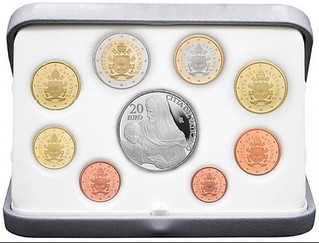 The Vatican issues at least two two-euro commemoratives per year in Brilliant Uncirculated and since 2015 also in Proof along with annual mint and Proof sets (the latter
with two versions — one with a 20-euro silver coin and the other a 50-euro gold coin) and several silver and gold commemorative issues each year, and starting in 2018 a second
version of the mint set that includes a five-euro bimetal coin. Prior to 2012, the annual Proof sets included silver and gold medals rather than coins.
The Vatican issues at least two two-euro commemoratives per year in Brilliant Uncirculated and since 2015 also in Proof along with annual mint and Proof sets (the latter
with two versions — one with a 20-euro silver coin and the other a 50-euro gold coin) and several silver and gold commemorative issues each year, and starting in 2018 a second
version of the mint set that includes a five-euro bimetal coin. Prior to 2012, the annual Proof sets included silver and gold medals rather than coins.
Vatican euro coins are classified under which papacy they were issued, and an image of the current pope normally appears on the obverse of every coin. These include 2002-2004 Pope John Paul II; 2006-2013 Pope Benedict XVI; and, since 2014, Pope Francis. However, since March 2017, the obverses have featured the coat of arms of the Vatican sovereign since Pope Francis made it known that year that he no longer wanted his likeness to appear on coins. The reverse of all Vatican euro coins features the common design used on all euro coins with the denomination and a map of Europe.
Vatican coins typically feature themes that reflect issues the pope of the time stressed, such as in his encyclicals and often depict saints, Jesus, or the Virgin Mary and biblical scenes, or highlight an important work of art from the Vatican collection or pay tribute to a legendary cultural figure. For example, this year, the Vatican issued a five-euro bimetal coin for the 250th anniversary of the birth of German pianist and composer Beethoven in 1770.

Recently, the Vatican issued its first coin sold at its face value — a 10-euro copper piece depicting the legendary Pieta statue created by Michelangelo that resides in St. Peter's basilica and was designed by Italian medallic artist and sculptor Chiara Principe, who has designed many coins for the Vatican and recently discussed her work on this and other coins with me. 43,000 of these coins were issued, and a Proof version limited to 4,500 is coming in October.
 The most well-known U.S. dealer in these coins (who sells a wide range of coins, stamps, medals, and books) is Peter Jencius of Jencius coins in New York City, who took
over the business after his father Edward passed away. Peter is also one of the leading experts on classic and modern Vatican issues and self-published an important reference work
on the first 50 years of Vatican City coins issued from 1929 to 1978, called Vatican City Coins 1929-1958, late last year. The book is written in English with a side-by-side
translation in Italian, since so many Vatican coin collectors are in Italy. Only 500 copies were published, and the book is available here.
The most well-known U.S. dealer in these coins (who sells a wide range of coins, stamps, medals, and books) is Peter Jencius of Jencius coins in New York City, who took
over the business after his father Edward passed away. Peter is also one of the leading experts on classic and modern Vatican issues and self-published an important reference work
on the first 50 years of Vatican City coins issued from 1929 to 1978, called Vatican City Coins 1929-1958, late last year. The book is written in English with a side-by-side
translation in Italian, since so many Vatican coin collectors are in Italy. Only 500 copies were published, and the book is available here.
The volume explains Vatican monetary conventions, investigates data about when annual issues were actually made, and consider how coins were packaged for collectors. By examining Vatican ordinances, the book corrects some historically printed mintages, provides meticulous descriptions, current valuations from the perspective of someone who knows the real market very well, and features enlarged color photographs of the coins. In addition, it is the first book of its kind that also classifies and illustrates over 25 different Vatican coin cases and coin cards (the latter being a popular way to package euro coins from various countries that is used today for the Brilliant Uncirculated version of Vatican two-euro pieces).
To read the complete article, see:
Collecting Vatican coins (http://news.coinupdate.com/collecting-vatican-coins/)
To read the earlier E-Sylum article, see:
NEW BOOK: VATICAN CITY COINS: 1929-1978 (https://www.coinbooks.org/v23/esylum_v23n04a03.html)

ARLINGTON NATIONAL CEMETERY TIME CAPSULE COINS
Max Hensley passed along this Atlas Obscura article about the opening of a 1915 time capsule in the Arlington National Cemetery Memorial. -Editor
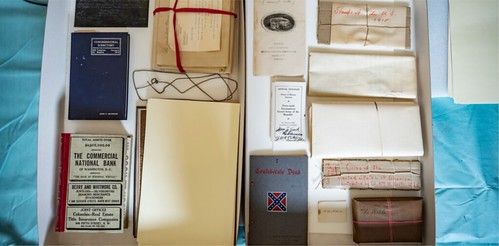
On October 13, 1915, when construction was beginning on the Memorial Amphitheater, a memorabilia box was sunk behind the cornerstone to fete the project. The copper box was stuffed with ephemera, including postage stamps and six coins; a U.S. flag; a Bible signed by the building's architect; copies of the Constitution and the Declaration of Independence; a photo autographed by then-President Woodrow Wilson, who was on hand to place the cornerstone; and a handful of local newspapers, including the Evening Star.
The same day, that paper ran a series of stories about the construction. One headline read "CARE TAKEN TO PROTECT PAPERS IN MEMORIAL CORNERSTONE," and the accompanying article zeroed in on all the ways that the people who'd prepared the time capsule had armored it against the elements. The story described it as finicky, exacting work—the task of an "anxious" crew committed to rethinking some of the procedures that had guided "all cornerstones heretofore laid in government buildings."
When historians, archivists, and conservators opened it in April, they found that all of those earlier efforts had paid off.
Far from floating in standing water, "everything inside was, as far as we could tell, dry," Smith says. "No signs of mold, most objects were wrapped or tied, everything appeared to be okay." The silk flag was swaddled in paper, and the Bible was wrapped in something resembling wax paper or oil cloth.
Max writes:
"Below is the picture of the six coins in what may be the earliest coin board. The donor became a General and is buried in the cemetery.
"I could find no inventory of the coins on-line, and the toning is mottled, so it is hard to make them out. They appear to be dollar, half, quarter, dime, nickel and cent. No gold.
"I wish there was more to report. We just have to revert to speculation due to casual work by National Archives. Very irritating."

Max adds:
"Since the capsule was emplaced in October, they all could be 1915, and probably would be Philadelphia in any case. Too bad things weren't delayed a year later. A 1916 standing liberty quarter might have made it in!"
To read the complete article, see:
The Things Inside This 105-Year-Old Time Capsule Have Hardly Aged a Day
(https://www.atlasobscura.com/articles/arlington-cemetery-time-capsule)
2020 HORNBY ISLAND TRADE TOKENS
Jim Bulmer created a series of trade tokens to raise funds for good local causes on Hornby Island in British Columbia, Canada. -Editor
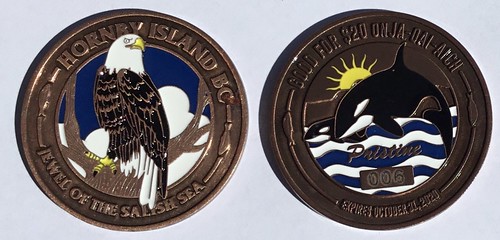
Jim Bulmer writes:
"We did the Hornby Island Token again this year - here is the article from our local paper."
I added Jim's images of the 2018 and 2019 tokens. -Editor
The Hornby Island Token Project is in its third and final year, and due to the COVID-19 pandemic, organizers have decided to use the entire issue to help fund food security on Hornby.
"Though they carry a face value of $20, this year they are worthless," said Jim Bulmer, the creator of the token. "That is…. most trade venues are closed, and tourism is expected to be at a minimum, so they are really not spendable."
2020's Hornby trade token was designed by local artist Michele Papp. On the obverse side is a sea eagle at rest in a tree; the reverse shows an orca swimming with her calf, with the word "Pristine," and herring swimming around the borders.
Conservation has been the overriding theme of all three issues of the Hornby token, specifically the southern resident orcas. Herring are also present on the 2019 and 2020 issues.
"They are called 'Grant's herrings' because he's where I got the idea," said Bulmer. "This year's motto is a six/seven couplet: 'Hornby Island B.C., Jewel of The Salish Sea,' which came from colleagues Carlyn and Karen in conversation."
The accompanying one-inch pin is also brass and enamel, and features the obverse of the token.
Also available are the 2018 and 2019 token and pin issues:
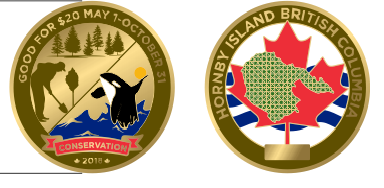
• 2018: Obverse – map of Hornby resting on a maple leaf; reverse – a forester planting trees, and an orca breaching.
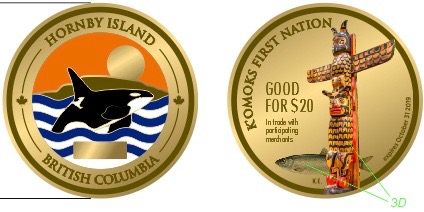
• 2019: Obverse – an orca swimming in front of Hornby Island; reverse – the K'omoks First Nation Pole at Helliwell Park, by Karver Everson, and a herring.
These serial-numbered tokens are two inches in diameter and are made of brass, inlaid with enamel. They are Canadian-made in Winnipeg by Awards Canada. This year's issue consists of 300 tokens and 500 pins.
All issues are available for a $20 donation, or buy all three for $50. Pins are $3 each, and display boxes are available at $4 each. All proceeds from sales will be donated to where it is needed, on Hornby Island.
Help contribute to the food emergency and send a colourful souvenir of Hornby to friends who can't visit this year. Pay by e-transfer, then Bulmer will mail the tokens, postage free. For more information, or to order any or all of the Hornby Island Token Project items, email Bulmer at jbulmer57@hotmail.com
Jim adds:
"Payment by E-Transfer, then I will send the Tokens by Snail Mail, Postage Free! Cheers, Jim"
To read the complete article, see:
2020 Hornby Island trade tokens of sentimental value only
(https://www.comoxvalleyrecord.com/community/2020-hornby-island-trade-tokens-of-sentimental-value-only/)
To read the earlier E-Sylum articles, see:
HORNBY ISLAND MUNICIPAL TRADE TOKENS (https://www.coinbooks.org/v21/esylum_v21n30a27.html)
2019 HORNBY ISLAND MUNICIPAL TRADE TOKENS (https://www.coinbooks.org/v22/esylum_v22n20a26.html)

MEDAL OF HONOR SOLD IN GERMANY
The Military Times covered the sale of a U.S. medal of Honor in Germany this week. -Editor
 A German auction house has sold an historic Medal of Honor — despite opposition from Sen. Ted Cruz and the National Medal of Honor Museum who urged the U.S. government
to intervene and stop the sale.
A German auction house has sold an historic Medal of Honor — despite opposition from Sen. Ted Cruz and the National Medal of Honor Museum who urged the U.S. government
to intervene and stop the sale.
Army Pvt. Thomas Kelly earned the Medal of Honor, the highest military award for valor, for his service in 1898 during the Spanish-American War while he was serving with Company H, 21st U.S. Infantry. The National Medal of Honor Museum says he was awarded the medal for rescuing injured soldiers as he came under enemy fire in Santiago, Cuba. Additionally, Theodore Roosevelt also earned a Medal of Honor for his valor in the same battle, the museum noted.
U.S. law bars the sale of military medals or decorations authorized by Congress, and those who violate the law could face a fine and up to six months in prison. Despite the urging from the National Medal of Honor Museum to remove the listing on Wednesday, Hermann Historica GmbH auction house sold the medal for more than $15,000 on Thursday.
National Medal of Honor Museum President and CEO Joe Daniels also wrote letters to U.S. government officials including President Donald Trump, Secretary of State Mike Pompeo, Secretary of Defense Mark Esper and Attorney General Bill Barr, calling on them to halt the sale of the medal.
"This Medal of Honor is a priceless American treasure that belongs here in our country," Daniels said in a statement Wednesday. "We're asking our elected leaders and officials in the administration to do what they can to prevent people from illegally profiting off of Private Kelly's heroism and bring the medal home where it belongs."
But ultimately, the efforts did not stop the sale from going through. Bernhard Pacher, the managing director of Hermann Historica, noted the law doesn't apply to him since he is not in the U.S.
"There's nothing morally bad in selling a medal, even if it's pointed out to me that it's illegal in the U.S., because I'm not in the U.S.," Pacher told Stars and Stripes.
This isn't the first time Pacher has sold a Medal of Honor either. Stripes reports he's previously sold four others, including one for more than $7,400. The auction listing says the item sold for €14,000 — more than $15,000.
There are strong feelings on both sides of this issue, but count me among those who feel the law is well-intentioned but misguided. I'm not sure if there are any other countries that have imposed such bans (does anyone have a list?) Britain's Victoria Cross medals are frequently sold, also bringing five-figure sums along with wide publicity and recognition for their recipients. -Editor
To read the complete article, see:
German auction house sells historic
Medal of Honor despite US opposition
(https://www.militarytimes.com/news/your-military/2020/05/28/german-auction-house-sells-historic-medal-of-honor-despite-us-opposition/)
SCOTLAND RELEASES "FABRIC OF NATURE" BANKNOTES
The Bank of Scotland has released a colorful new series of banknotes. See the complete article online for more images. -Editor
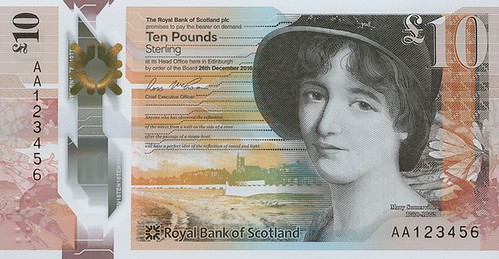
Portrait of scientist Mary Somerville on the front of the £10
The Royal Bank of Scotland has started the new decade off right with its release of a series of banknotes deemed Fabric of Nature. With artwork featured across their fronts and backs, each bill highlights a significant Scottish woman and an indigenous species of Scottish wildlife. The series was led by the Scottish design company Nile, in partnership with O Street, Timorous Beasties, Graven, and Stuco.
On the front, these colorful polymer bills honor the likes of author and poet Nan Shepherd, scientist Mary Somerville, and businesswoman and patron of the arts Kate Cranston with delicate portraits. The artwork illustrated across the bills' backs depicts Scottish fauna scenes of otters, mackerel, and squirrels at play.
"From the typography to the featured animals, to the bespoke textile backgrounds, every element of every note has a meaning connected with the people of Scotland. The notes are a cultural capture of what is important, and heart felt for us Scots," the design company exclaims. The series of £5, £10, and £20 notes offer a beautiful display of national pride.
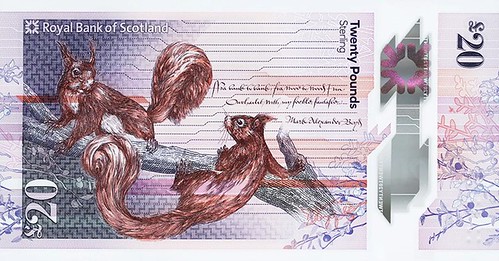
Illustration of squirrels on the back of the £20
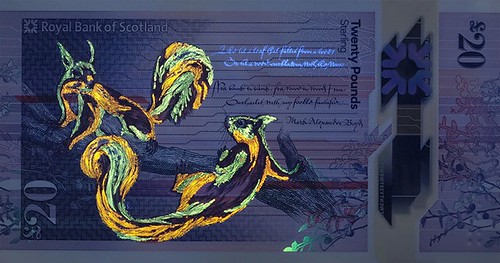
Back of £20 banknote illuminated by UV light
To read the complete article, see:
Scotland Releases Colorful Currency That Honors Scottish Women and Wildlife
(https://mymodernmet.com/scottish-banknotes/)
LOOSE CHANGE: MAY 31, 2020
Here are some additional items in the media this week that may be of interest. -Editor
Tuvalu's Collectible Coins
This article provides some background on the Tuvalu arrangements with the Perth Mint. -Editor
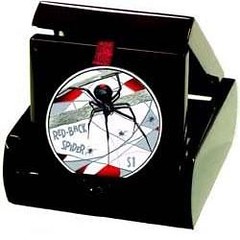 As the coronavirus pandemic hits economies around the world, the tiny Pacific nation of Tuvalu has carved out a lucrative niche — producing designer coins featuring the
likes of Star Trek, John Wayne and even Duff Beer.
As the coronavirus pandemic hits economies around the world, the tiny Pacific nation of Tuvalu has carved out a lucrative niche — producing designer coins featuring the
likes of Star Trek, John Wayne and even Duff Beer.
Tuvalu's coins are designed, crafted and marketed in Australia as part of a decades-old agreement between The Perth Mint — a company owned by the Western Australian Government — and Tuvalu.
As part of the deal, Tuvalu receives a minimum of about $200,000 per year in royalties.
Adelaide coin and collectables trader Mark Nemtsas has sold dozens of Tuvalu coins from his Purple Penny coin store over the years.
"The most popular one is probably the 2006 redback spider one ounce silver coin, which I think was released for about $80, but these days trades for over $1,000," Mr Nemtsas said.
"It's probably their most popular and well-known coin."
Tuvalu is not the only Pacific country that sells collectable coins — the Cook Islands and Fiji have similar deals with The Perth Mint.
But according to traders, Tuvalu is one of the most successful and well-known around the world for its unusual coins.
"People are quite taken by the designs and quite taken by the quality of the product, not just the coin, but the packaging and all the material that comes along with them," collectables trader Mr Nemtsas said.
To read the complete article, see:
Why the tiny Pacific nation of Tuvalu wants a bigger share of the collectable
coin market (https://www.abc.net.au/news/2020-05-31/tuvalu-pacific-collectable-coins-perth-mint/12290590)
William Sheldon
David T. Alexander published an article on CoinWeek about author William Sheldon. See the complete article online. -Editor
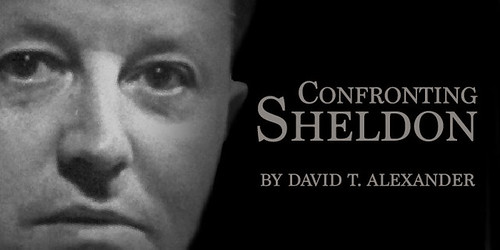
Dr. William Herbert Sheldon, born on November 19, 1898 and dying on September 17, 1977, was venerated for decades as one of the historical giants of American numismatics.
During his later life he took the stage as the godfather or even the resident deity of the highly specialized field of early American copper cents. These were the large cents first struck in 1793 that were among the earliest U.S. coin denominations collected and intensely studied by American numismatists after these coins were discontinued by the Philadelphia Mint in 1857.
Though gone now for almost half a century, Sheldon's spirit will undoubtedly remain at the heart of that collecting specialty for a long time despite scandal and disillusionment among large cent devotees. Adding to Sheldon's unique status is the enveloping cloud of dark memory surrounding his chief disciple, the late Walter H. Breen. In death as in life, the two remain inseparable and their intertwined careers still challenge their surviving friends and enemies.
To read the complete article, see:
Confronting Sheldon (https://coinweek.com/us-coins/confronting-sheldon/)
Thrift Store Find: $100,000 Drawing
Numismatists and bibliophiles are always on the lookout for bargains. It's a year old story now, but this non-numismatic article shows that thrift shop and flea market finds can still be had. -Editor
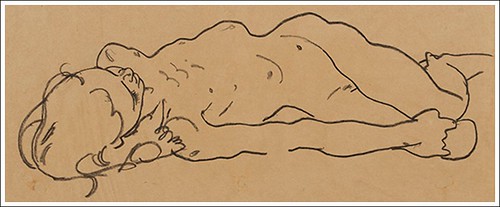
An eagle-eyed thrift store visitor made the discovery of a lifetime last summer when he was browsing through discarded objects and ephemera at a Queens-based Habitat for Humanity store and stumbled upon an elegant line drawing. It turned out the work was by none other than Austrian artist Egon Schiele.
Jane Kallir, the director of Manhattan's Galerie St. Etienne and the author of Schiele's catalogue raisonné, told The Art Newspaper that the buyer, who prefers to remain anonymous, is a part-time art handler who has "got some art background—an eye." Kallir, who has been authenticating Schiele works for decades, was initially skeptical of the find. She estimates that claimants who think they have a legitimate work by the artist are wrong "90 percent of the time."
The drawing is now on view through October 11 as part of Galerie St. Etienne's show "The Art Dealer as Scholar" alongside works by Käthe Kollwitz and Alfred Kubin. It is on sale at the gallery for a price between $100,000 and $200,000. If it sells, a portion of the proceeds will be donated back to Habitat for Humanity as a kind of karmic thanks.
To read the complete article, see:
A Drawing Found in a Queens Thrift Store Turned Out to Be a Genuine Egon Schiele Worth
as Much as $200,000 (https://news.artnet.com/market/egon-schiele-discovered-queens-thrift-store-1609672)
FEATURED WEB SITE: ANCIENT ROMAN AND GREEK COINS
This week's Featured Web Site is the Ancient Roman and Greek Coins educational section of the Augustus Coins site.
http://augustuscoins.com/ed/

